Author: Mike Matthews
My apologies for the three-week span between posts. I should have expected it. My new job takes a lot of my time. First things first: I love it. I love the people I have met, and I’m inspired by all that my new district does so well. It’s a spectacular place.
I’m lucky for many reasons, but one of them is that I have taken jobs, from teaching to being a superintendent, in six different districts in my career, and I have always been surrounded by wonderful students and caring, talented people who love what they do. My new district is not one bit different.
From time to time, I will take what I have shared with my community and make that the focus of my blog post. I wrote the email below to all employees after the first three days of school. During those days, I visited all 34 schools in the Placentia – Yorba Linda Unified School District. That’s a lot of schools! After digesting those visits over the Labor Day weekend, I sent this email to all employees.
—–
The first day of school. It’s an annual tradition that stands alone. Opening Day in Major League Baseball comes close, but I can’t think of much else that does. It’s a day when we look forward to renewing friendships, meeting new people, learning something new, doing as well or better than the previous year, improving our habits, and taking one more step to whatever is next. For students, there are thirteen first days of school between kindergarten and high school graduation – and all of them should be special.
And for all of us who work in PYLUSD, we get to experience a whole lot more. Last Wednesday was my 55th first day of school! And though it feels far different to experience the first day as a student and as an employee, it still brings that same excitement. In baseball, the fans, players, managers, groundskeepers, and all of the other employees have vastly different experiences, but they all look forward to that special first day and all that the season might bring. Fifty-five years in, I still get excited, and I know that here in PYLUSD, I am surrounded by good people feeling that same sense of positive anticipation.
I was lucky enough to visit all 34 of our schools during the first three days of our school year. Thanks to the efforts of all of us, our campuses and our employees were ready for our students as they walked into our quads, hallways, cafeterias, and, of course, our classrooms.
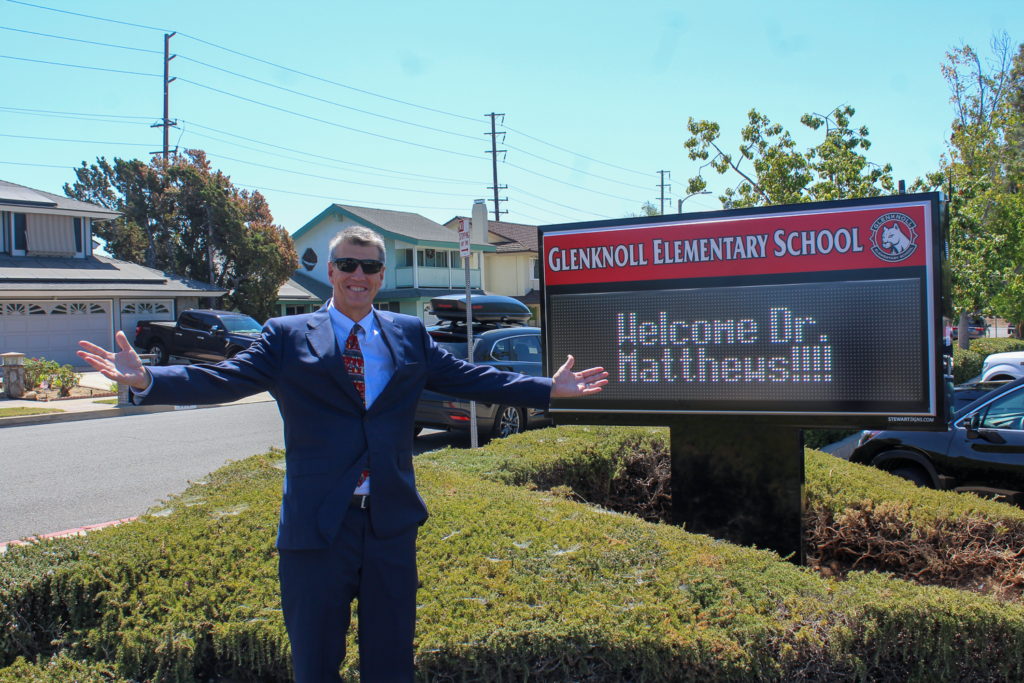
Some of the highlights for me were:
- Our campuses are clean, well-manicured, and welcoming places for our students and our community. I have worked all over this state, and I have never seen anyone do this better than we do.
- We were ready as we served more breakfasts to more students than ever before.
- In a time when staffing challenges are everywhere, we had highly talented employees transporting, greeting, teaching, and supporting our students on every campus.
- In talking to many of our employees, my favorite comment was, “I was born to do this work.” That sense of pride and passion was evident on every campus in our district.
- Teaching and learning were in full swing on day one.
- Like almost every first day, the temperature outside was way too high! We used the shade well, and all of us appreciated our air conditioning. And when a few classroom AC systems glitched, our Maintenance and Facilities staff rushed to address it as quickly as possible. It was very impressive.
- All of our new students, including our K and TK students, were seamlessly integrated into our schools, and as we enter this week, they are now fully included in the PYLUSD family.
- The schedules at our secondary schools worked extremely well. Most people do not sufficiently appreciate the challenge of scheduling nearly 8,000 high school students and over 4,000 middle school students into 6 or 7 periods during the day. We did a spectacular job, and for the small number of students who sought changes, we jumped on it immediately.
And in all of this, there were smiles, there was warmth, there was hope, there was pride, and there was a strong sense of positivity in every student and employee I encountered.
For all of this, I say, “THANK YOU!” Thanks for everything it took to be ready for the first day of school. Thanks for loving and welcoming each and every student with such positivity and warmth. Thanks for inspiring our students to new heights and for supporting them whenever they need it. And thanks to each of you for being the heart and soul of PYLUSD.
—–
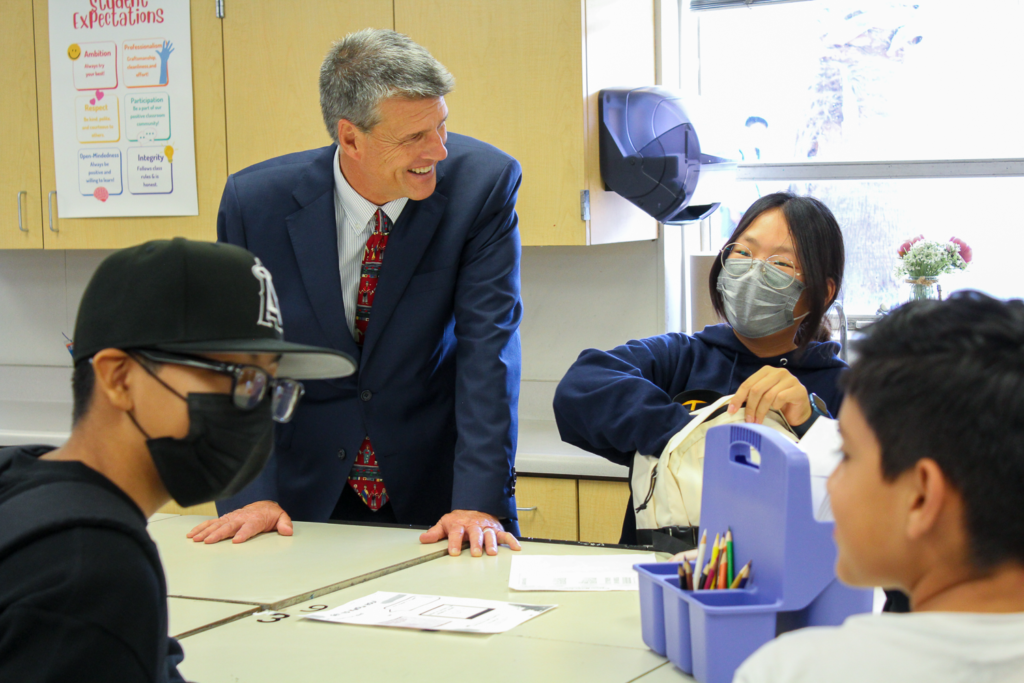
I am so proud to work alongside every employee here, as we remember the excitement, the hope, and all of the possibility that comes with the first day of school. Let’s all have a great week two!
Then yesterday, we sent out a my welcome back video to all families and all employees. I’m lucky to have a team of leaders, teachers, staff, and students who all contributed to the creation of this video. You can see that video here.
To all of you who are working in schools or have kids attending them, I hope the start of your year has been outstanding! Thanks to all of you who have made our schools better and better over the years, and I’m looking forward to another great year
To get updates on when my next post comes out, please click here
I love it when people comment on my blog posts. I was inspired to write this post when my friend Rose Ann commented on my last post, recalling how the two of us were always highly competitive in the elementary school spelling bees and math speed drills. I look back and wonder what I took away from those kinds of contests and drills. I certainly learned that memorization was essential to learning. I learned that speed was highly valued. I learned that I was really good at math and pretty good at spelling. (Does anybody really need to know how to spell chrysanthemum?) And I learned that either it’s right and you stay standing, or it’s wrong and you shuffle back to your seat.
Unless you have a career as a Jeopardy contestant, life is not about speed or single chances. And in the half century since I was in elementary school, there has been some change in our classrooms.
We need to keep that change going in the right direction.
There are different perspectives on what is really learned in those types of exercises. Brian Regan (see below) has been one of my favorite comedians for years. His take on spelling bees is hilarious and sad. It’s worth four minutes of your time to click here and listen. My favorite part – the kid who is asked to spell CAT and says, “Cat. K-A-T. Cat. I’m outta here.” Get the humiliation over with. There’s a place for those who wish to compete in spelling bees, geography bees, and contests that reward memorization and quick thinking. But if you are looking for the best kind of classroom learning, the kind of learning that helps you lead a successful life, it’s about struggling, failing, getting feedback, struggling more, and eventually figuring it out.

Miley Cyrus put this perfectly in her song, The Climb
There’s always gonna be another mountain
I’m always gonna wanna make it move
Always gonna be an uphill battle
Sometimes I’m gonna have to lose
Ain’t about how fast I get there
Ain’t about what’s waiting on the other side
It’s the climb
Carol Dweck and Jo Boaler, two highly regarded Stanford professors (that’s Jo Boaler in the center in the picture above!), have been researching and advocating for the climb for years. Angela Duckworth discussed the same idea in her very popular work, Grit. Hard work matters. Practice matters. (Sorry, Allen Iverson and Ted Lasso.) If you struggle to get better, you actually learn more in the process.
We parents and teachers should never emphasize speed. We should be telling students and children that with effort, they can become better at math, better at reading, and better at whatever they put their minds and their efforts to. This is Dweck’s concept of growth mindset. Our intelligence and ability are not fixed. We can get better. We can get more intelligent and more skilled.
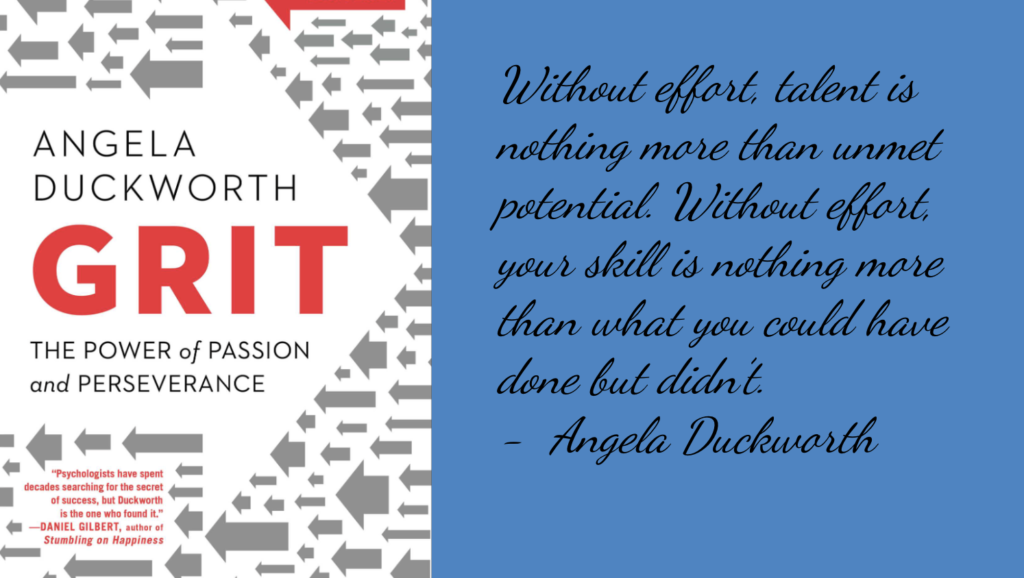
I’ve known so many outstanding high school coaches who beautifully embrace growth mindset. When players did not run a play correctly, or when they were trying to learn a new technique to make them faster or stronger, these coaches would correct the student-athlete (sometimes gently, sometimes bluntly), then have them run the play or use the technique again. And again. And again. That’s how learning happens best. You try to do something that is not at all easy to do, get feedback, get better, get feedback, and so on until you reach your maximum potential. It is beautiful to watch.
But often those same coaches, when working with students in the classroom, will teach something, give a test on it, and then move on to the next topic whether the student learned it or not. They would never accept such failure as a coach.
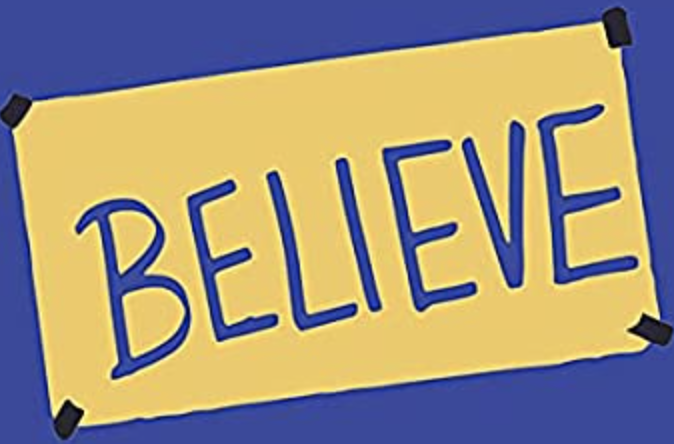
Real learning does not involve students recalling something from memory, which can lead to spelling something wrong then taking the walk of shame back to their desk. Real learning endeavors to teach a challenging and useful skill or concept, then to find ways to help each student, encouraging them to work and struggle along the way, until they get closer and closer to mastery. If students can learn those concepts, they can figure things out on their own later.
I’m a pretty darn good memorizer. I know that water boils at 212 degrees Fahrenheit and 100 degrees Celsius. (I will write a blog post one day about our refusal to adopt the metric system – we make things so much harder for ourselves by rebelling against the beauty and simplicity of the metric system – but I digress.) One day, Jill was cooking and yelled out as her hand got hurt by escaping steam from a pot. Dawson and I both expressed our sympathy, then Dawson commented that it must have really hurt, as steam is hotter than boiling water. I didn’t know that fact, so naturally, I challenged my son on his statement. “So how hot is steam?” I asked. He said, “I don’t know, but it’s hotter than boiling water.” I asked how he knew that and he said, “It just makes sense. The water reaches 100 degrees Celsius, and the only reason it would change into steam would be that it has more heat than the boiling water.” I asked where he read that, and he said, “Nowhere. It just makes sense.” Being an amazing and trusting father, I immediately looked it up. And what-da-ya-know – he was right.
Memorization is nice, but it’s not the goal of learning. Understanding blows the doors off of memorization.
When students don’t get the concept at first, we need to stay with it, give them second chances, encourage their grit, and support their struggle. When a piece of writing is not what it should be, we need to teach students to grapple with the editing process and develop a never-ending desire for improvement.
It’s not about speed. It’s about embracing the challenge. Jo Boaler writes, “I work with a lot of mathematicians, and one thing I notice about them is that they are not particularly fast with numbers; in fact, some of them are rather slow. This is not a bad thing; they are slow because they think deeply and carefully about mathematics.”
So let’s embrace the climb. Let’s not give outstanding comedians like Brian Regan the fodder for jokes about bad teaching. Let’s believe that all students can get smarter. And let’s all join our students in the lifelong struggle to get better.
Mike
To get updates on when my next post comes out, please click here
Sources:
Mindset: A New Psychology of Success, by Carol Dweck
Limitless Mind: Learn, Lead, and Live Without Barriers, by Jo Boaler
As a kid who grew up in Arkansas, I never even imagined living in Los Angeles. LA was glitzy, red carpet, rich and famous, Hollywood Stars, Beverly Hillbillies. I moved here in 1993. And as a lifelong public school educator, I was never going to be one of those celebrities. The rich and famous lifestyle, the TMZ glitz – it’s just not who I am.
But if you think that’s what LA is all about, you’re missing the boat.
The true icons of LA, the most beloved and revered, are some of the most cerebral, kind, humble, and society-improving people the world has ever known.
I started thinking about that last week, when Vin Scully died at the age of 94. The outpouring of love and tributes after his death was overwhelming. Through his humble story-telling style, his longevity (he announced 67 baseball seasons), and by staying true to what he loved, he became a close friend to so many, either through a transistor radio, a car radio, and/or a tv broadcast. And it was never about him. He was a front-row ticket to every Dodger game, a conductor for the magic of baseball, and a friend with whom you could pass the time like no other. He made the great moments even better (After Kirk Gibson hit his game winning home run – “In a year of the improbable, the impossible has happened”), and the mundane moments enjoyable (talking about the life of Socrates in the middle of a no-meaning game that wasn’t even close). He was humble, brilliant, and he loved the Dodgers, as well as LA. He made life better for millions of people seeking a connection to baseball, a connection to the community, or just a story well-told.
He was also a Presidential Medal of Freedom winner. As President Obama honored Vin, he said, “Most play-by-play announcers partner with an analyst in the booth to chat about the action. Vin worked alone and talked just with us.” President Obama added, “When he heard about this honor, he asked with characteristic humility, ‘Are you sure? I’m just an old baseball announcer,'” Obama said. “And we had to inform him that, to Americans of all ages, ‘You are an old friend.’”
Vin Scully was the essence of LA and stands among the greatest of us. And as I found, there are other Los Angeles-based Presidential Medal of Freedom winners who are true heroes and legends of our community.
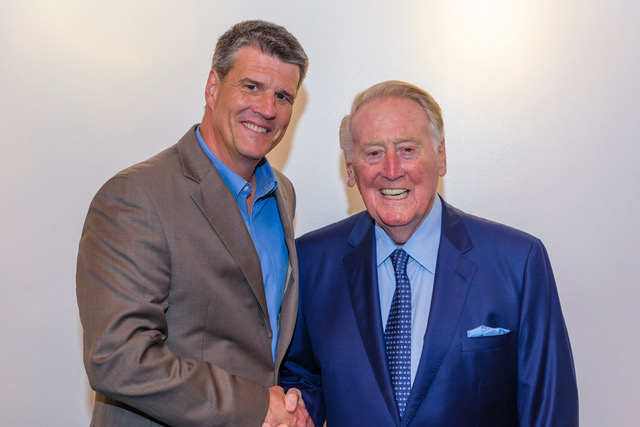
John Wooden was the Ted Lasso of his day. Wait. Scratch that. John Wooden, the Wizard of Westwood, was the greatest coach of all time. President Bush awarded the Medal of Freedom to him in 2003, and just like Vin Scully, there was nothing about him that wanted attention or glory. John Wooden wanted his athletes to become humble, successful, and hard-working young men, who could be counted on to take the extra step to do what was right. Yet, his teams won like no other. (10 National Championships, 38 straight NCAA tournament victories, four perfect 30-0 seasons, 88 consecutive victories, and 20 PAC-10 championships.)
Wooden’s Pyramid of Success is brilliant and touching. It is simple, yet overwhelming. That’s why it’s perfect that Coach Lasso has it hanging in his office. It’s hard to argue with a modern-day 25 commandments. The central quote on his Pyramid is, “Success is peace of mind which is a direct result of self-satisfaction in knowing you did your best to become the best that you are capable of becoming.” He lived by that saying every day and imparted it to all who would listen. Like Vin Scully, John Wooden epitomizes LA. He was humble, cerebral, dedicated to others, and constantly worked to make the world a better place. Winning was the icing on the cake.
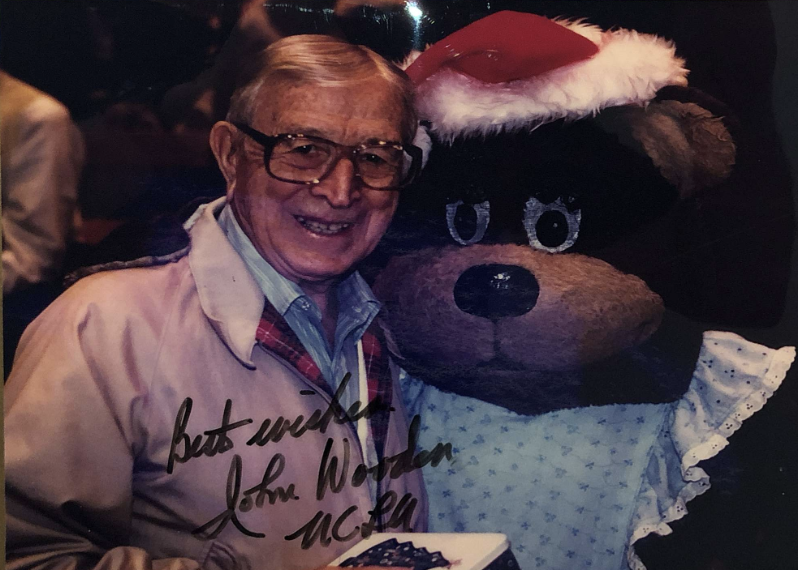
Jackie Robinson was another Presidential Medal of Freedom winner. President Reagan honored him in 1984. Enduring the slings and arrows of so many who were not ready for integration into America’s pastime, Jackie Robinson broke countless barriers. He thrived at UCLA and he showed millions of people how wrong they were about segregation and inclusion. He was strong, resilient, highly intelligent, a wonderful team member, humble, and a talent like no other. Jackie Robinson is also LA.
And we cannot forget about Kareem Abdul Jabbar who was awarded the Presidential Medal in 2016 by Barack Obama. And although I did not mean for this post to become a UCLA love-fest, let’s call it like it is. Go Bruins! No one has scored more points in the NBA than Kareem. Few have had college careers like him. He is an intellectual, a man of deep faith, and somehow found a way to humility in spite of his greatness. Kareem spoke at my nephew’s graduation ceremony at LMU in LA. I included the points of his speech below, but just know it reflects on humility, happiness, and the simplicity of living well and making a difference. And as a fellow blogger – (with the exception of talent and grace, and height, and, well, lots of other stuff, my blogging colleague Kareem and I are basically the same person) – I have great respect for his writing, his efforts to celebrate what is good, and his kind yet blunt push when something is wrong. Kareem is LA too.
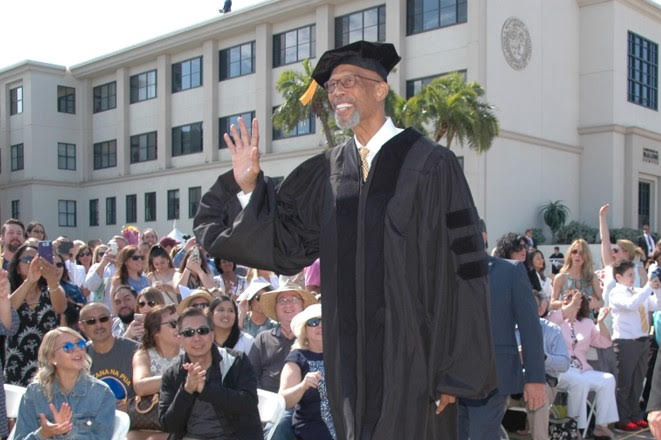
So, while this post started as a tribute to Vin Scully, when I saw the list of others from LA who have been honored with the Presidential Medal of Freedom, it evolved into something broader. The qualities of these four remarkable people have engendered almost a universal respect and reverence. The outpouring that we all witnessed after Vin Scully’s death has been a perfect example of that respect. All four earned that very rare form of admiration not through the glitz and red carpet that typifies LA for so many, but through the values of kindness, humility, selflessness, a commitment to continuous improvement, and a desire to improve the lives of others. I love living in a community where these are the values most celebrated and most loved.
I’m always looking for inspiration to help me lead my life better. As you can see, that inspiration is all around me. As Randy Newman sang, “I love LA!”
Thanks for reading, and keep let’s all keep reaching for improvement.
Mike
To get updates on when my next post comes out, please click here
Notes on the photos:
- The picture of Vin Scully is from a speaking event where I was fortunate to meet him before the event. He was kind and gracious to all of us, and we all felt so lucky to be there. Word has it that’s how he was with all of his fans throughout his long career.
- My mom, Sue Scully, is an outstanding photographer. She took the picture of Kareem as he walked by us in the procession at the LMU graduation ceremony. Very cool moment.
- The picture of John Wooden with Josephine Bruin was taken in the late 1980s, when my amazing wife was the person behind the mask. (I’m not sure I’m supposed to reveal that information, so let’s keep it between us.)
My notes from Kareem’s LMU Commencement Address
- You are not the future. Make the most of the present.
- Thank the people who have helped you get to where you are today.
- Have regrets. Take reasonable risks for things that are worthwhile
- Play more. Don’t forget – Plan one thing every day that you look forward to. Don’t just work for the weekend.
- When choosing romance, compassion is more important than passion.
- Curiosity is critical for your success. Most people never change their opinions after age 21. We should always be learning.
- Use your power for good.
- Put peanut butter on everything!
- Be patient. Arthur Schopenhauer, “Talent hits the target no one else can hit. Genius hits the target no one else can see.” Patience allows for genius.
- Stop watching any show that includes any member of the Jersey Shore cast.
- Everything doesn’t have to be fixed right now.
- Be prepared for what’s next. Life is a series of graduations and transitions, all of which will redefine you.
Also – I had this paragraph in there in an earlier draft, but took it out when I realized Ashe did not stay in LA. I’m always looking to shorten my posts, but I’m kind of sorry I did not include it.
What about Arthur Ashe? (1993- Bill Clinton) Recruited by UCLA when no one else was interested, he became a citizen of the world. He wanted to become the Jackie Robinson of tennis. I don’t know if there will ever be another Jackie Robinson, but Ashe crushed it. While winning around the globe, he made the world aware of the injustices of Apartheid, and fought for humanity for those infected with AIDS. And he did all of it in a quiet, cerebral, and remarkably fierce way. I watched the Ashe documentary now showing on HBO. It’s like Ashe – understated, non-flashy, and spectacular. Arthur Ashe is LA.
I suffered just enough.
A while back, as I prepared for our every-other-year bike trip, I wrote that I had begun my cycling training a little too late. Last week, our group of friends took our 6th trip together, biking through the hills of the Paso Robles wine country and the central California coast. We biked about forty miles a day, and I was able to complete all the rides, suffering only mildly, and enjoying all of it.
I love these trips. To me, they are a perfect use of vacation time. The days are active – we wake up fairly early, and we are on our bikes (AIS – A** In Seat) by 8:30am. On the rides, I experience exploration, physical exertion, companionship, beauty, the outdoors, exhilaration, and in the end, a sense of accomplishment. We try to finish before lunch, so the rest of the day can be spent doing anything – eating, napping, exploring, wine tasting, or just taking in a new area. I exercised four hours a day and gained weight on the trip. Again, perfect. I thought I was doing well to add a few extra pounds, but my very strong friend Mark crushed me, gaining a full ten pounds. He’s definitely an over-achiever.
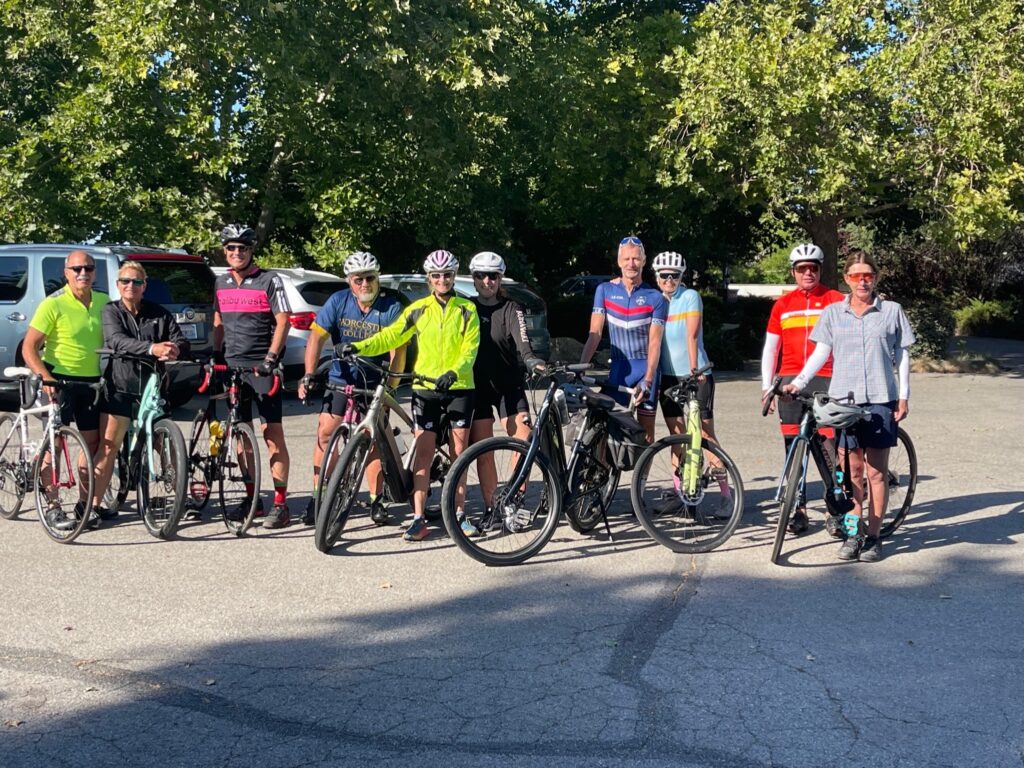
I try to make the most of each and every vacation day. I have found that these days help me in my long work weeks throughout the year. I feel like the time away is truly a gift. My sentiments are best explained by a relatively new concept called time affluence. I first learned about it from Dr. Laurie Santos, the professor who teaches the most popular course at Yale. Her course is all about the science of the pursuit of happiness – it’s called Psych 157: Psychology and the Good Life. (See notes at the end.)
Santos pushes the idea that one way we are happier is when we believe that we have plenty of time. The great thing is, we can all choose to feel time affluent. One way of feeling time affluent is to make the most of your vacation. Using research from Dr. Santos’ course and my own experience, here are some thoughts I have about using these trips as a means of maximizing time affluence.
Take all of your vacation time: I take every day of vacation time every year, and I advise everyone I work with to do the same. Clarification: I did not say take all of your sick leave. Over the years, I have been fortunate to earn one sick day for every month of work, and to work in an industry that allows me to take my sick days with me as I moved from one school district to another. As of today, I have 361 sick days. I’ll be fortunate to have them if I’m sick, but to me, a good rule of thumb is, if you are healthy, GO TO WORK ON THE DAYS YOU ARE SUPPOSED TO BE THERE! But vacation – that’s something different. Use it all.
Once Vacation Starts, End the Stress of Preparing for it: When I was young, my parents, all four kids, and our dogs would squeeze/pile into our Volkswagen Squareback or wood-paneled station wagon after what was always a very stressful last hour of final preparations. During that last hour, Dad would be yelling about us not being ready, and we would all be wondering why he was yelling at all of us, when clearly one of our other siblings was to blame. It was probably Bill’s fault, because he was the youngest. Then, after all of the craziness and yelling were done, and once the car doors were shut, my dad would take a deep breath, then loudly yet pleasantly announce, “Vacation has started. NO MORE ARGUING AND NOBODY CAN GET ANGRY!” At that moment, he would turn on the radio or put in an 8-track tape, and we were off driving on some new adventure, leaving behind all the stress of the moments before.
Pursue Active Leisure Time: Engage in your favorite hobbies, enjoy meals with friends, try something new and adventurous, exercise – do fun stuff. Active leisure allows my mind to get into the state of flow that I’ve written about before, where I am fully engaged in whatever I am doing, and not letting any other worries creep into my head.
Pursue Idle Leisure Time: One of my favorite hours spent on this vacation was observing over one hundred elephant seals sunning themselves on the beach. Those guys know what idle leisure time is all about. There’s a time for swimming gracefully, and there’s a time for lugging their 2-ton bodies up on the beach and doing . . . nothing. I’m not a great nothing-doer, but I’m an outstanding napper. Gifted, in fact. One of the great failures of our nation is our refusal to adopt the siesta as a way of living. I’m not much of a sit around and talk for hours guy, but playing cribbage, cooking, and eating long meals – and napping . . . I’m all in for that. Downtime is good for the soul, and the science of happiness confirms that.

And through all of it, consciously take the time to reflect and feel grateful for the time that allows for the lack of stress, the active leisure, and the idle leisure. That gratitude is what makes us feel so time affluent.
So, do your best to be flexible, to get along, to take alone time when you need it, and to make the vacation special for everyone on the trip. It’s going to be great. Enjoy every moment.
All of us can make choices that can allow for time affluence, not only on vacations, but in our daily lives as well. I’ll write about that later.
Thanks for making time to read this post. As always, I’d love to hear your thoughts.
Mike
To get updates on when my next post comes out, please click here
Notes:
Anyone can take Dr. Santos’ course. If you want a good article advertising itself as a cheat sheet to the course, check out this article by Adam Sternbergh.
To actually take the course online for free, you can take it through Corsera by clicking here.
No one goes to Malibu, my home since 1993, in the summer. It’s way too crowded. OK – that’s a stolen line. The famous Yankee catcher/American philosopher Yogi Berra said that about a restaurant in New York. He was a quote machine. But truly, there is no worse time to be in Malibu than the summer.
People hear about Malibu, and they think about a playground for the rich where the stars play. That’s not the life I lead. My friends are contractors, teachers, professors, jewelry makers, difference makers, doctors, midwives, photographers, and yes, a few people in the movie business. Yet, none of us are part of the Malibu “scene,” whatever that is. But we are into the natural beauty of our gorgeous beach town, and we all feel fortunate to live in a beautiful place with friends who are so close they are practically family.
The beaches are the thing in Malibu. Maybe. Actually, I could write a whole separate post that starts with “The mountains are the thing in Malibu.” But let’s focus on the beaches, which are used in so many ways. I took a bike ride up and down the coast last Sunday. It’s one of the world’s most beautiful rides. But the ride is along Pacific Coast Highway and, in the summer, you have to get on the road before 7 AM and be done by 10 AM, because the road gets busy around 9 AM, and the later the day goes, the less I trust driver attentiveness.
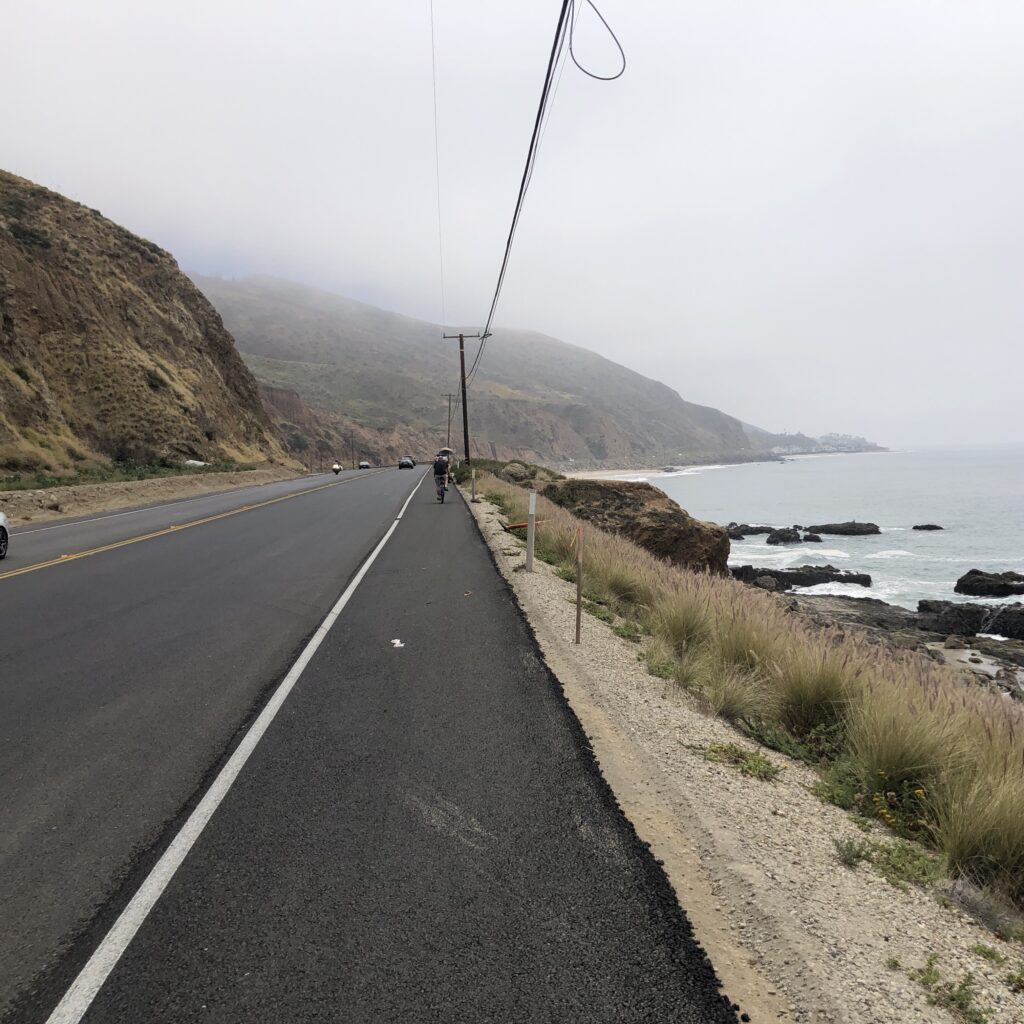
While the 7 AM start was the right goal, I made the poor decision to stay out way past my preferred 10 PM bedtime on Saturday night (I blame my aforementioned friends), and yada, yada, yada, I did not get on the road until 9 in the morning. It was warm, sunny (the picture above is a 7 AM picture from a different ride – still very foggy), and way too late. My three-hour journey gave me plenty of stories to tell that should explain why Malibu is such an amazing place, and why no one should come here in the summer.
I left my home, rode past the cars of people who drove for miles to park here and start their bike rides, and turned right onto Pacific Coast Highway (PCH). Almost immediately, I was passed by a 5-minute convoy of Ford Mustangs – all years, all colors, and most of them with mufflers that were not fully functional. Shocking. And needless to say, very loud. Shelbies, Cobras, ‘65 convertibles, you name it. That’s a thing on PCH – these rallies or convoys of Mustangs, Ferraris, modified Honda Civics, Harleys, and more. I will say, the convoys are super fun to see. However, it doesn’t feel super safe to be riding in a noise factory surrounded by drivers who are staring lustily at each other’s prized possessions. Like I said, I started too late.
In case you were worried, those in the ocean are safe from the car traffic. And as I rode up the coast, I could see that the surf was up, and the surfers were out in droves. In sections of the coast where the surf is not as big, I saw people fishing, both above and below the water. While slowly ascending one of two main climbs on the ride, I rode past a parked truck and saw a guy getting his spear gun from the back of the truck. It was pointed right at me as he gently pulled it from the truck bed, and I said a silent prayer that I would not be his first catch – a prayer that was thankfully answered. You have to be hearty to take advantage of the ocean. Growing up swimming in the warm lakes of Arkansas and learning to scuba in the very warm Gulf of Mexico, I am a full-fledged cold-water wimp. Anything below 65 degrees just hurts. The Malibu ocean-lovers are out there all year long, with water temps that range from 55 to 70. But when my friend David (one of those I blame for my late start on Sunday) occasionally knocks on my door to give me two lobsters that he caught free-diving that morning, I am most grateful for those heartier than I.
You don’t have to be in the water to enjoy Malibu’s beaches. Low tide walks on the beach are spectacular, and there were a lot of walkers out there on Sunday. I remember seeing the wide beaches of Malibu for the first time when I was applying for the principalship of Malibu High School in 1993. They were stunning then, and I still marvel at them today.
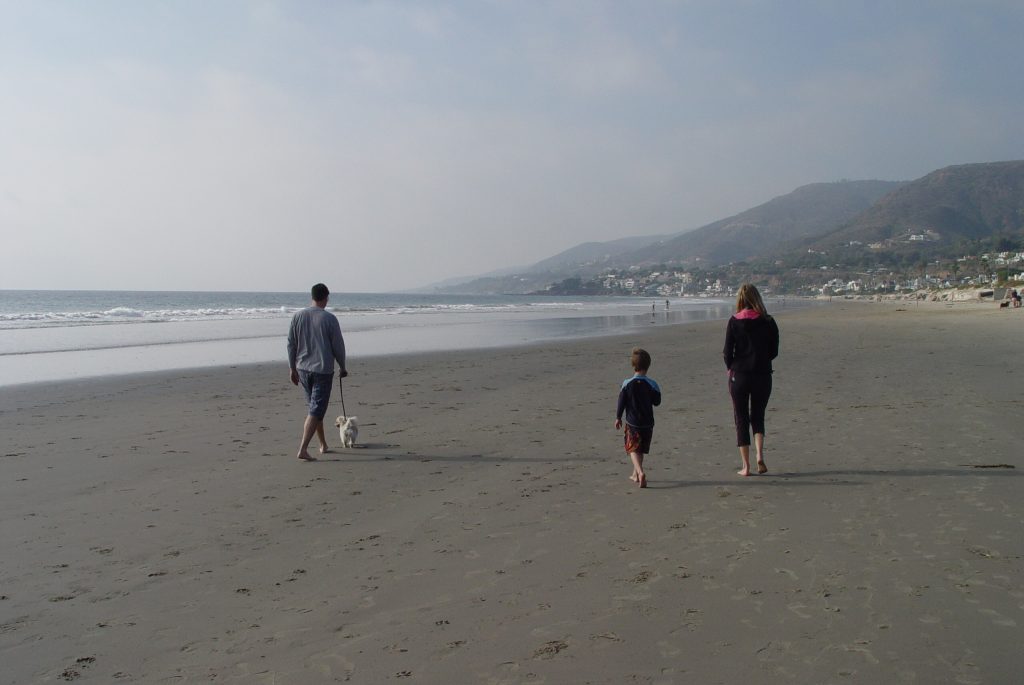
Looking for dolphin, diving pelicans, and the occasional whales makes every trip to the beach something special. Although it’s not whale season, the dolphins and big-mouthed birds were out and putting on their show.
All of this stuff happens every day – you just see more of it as the day goes on. Maybe that late start isn’t all bad.
Even though nobody comes here in the summer, the not too foggy days between Labor and Memorial Days can bring 200,000 to 500,000 visitors to Malibu’s beaches, and over the course of a good-weather summer, our beaches receive almost 100 million visitors. Like I said, it’s way too crowded, and nobody comes here. Except … everybody comes here. And why wouldn’t they? Malibu’s beaches are state and county parks and the lifeguards are our awesome park rangers. I am a huge fan of our local, state, and national park system (thanks Teddy Roosevelt!), and the beach parks of Malibu are just one more thing that makes this nation the great place that it is.
My request for those of you who venture here – enjoy a truly beautiful place, throw your trash away, don’t make illegal U-turns on PCH (channeling my last post, that’s how people DIE), and please watch out for cyclists who start their day a little later than they should have.
Thanks for reading!
-Mike
To get updates on when my next post comes out, please click here
Note: The wide beach picture was taken a long time ago, when Dawson was very little. It features our Jill, Dawson, me, and Penny, our Pekingese. I thought the picture nicely portrays walking on the wide beaches. It’s also a picture I featured in a blog post I wrote after Penny’s death. I have two friends who lost their beloved dogs this week, and I was reminded of the sadness of losing those dogs we love, and all the beauty of the years with them.
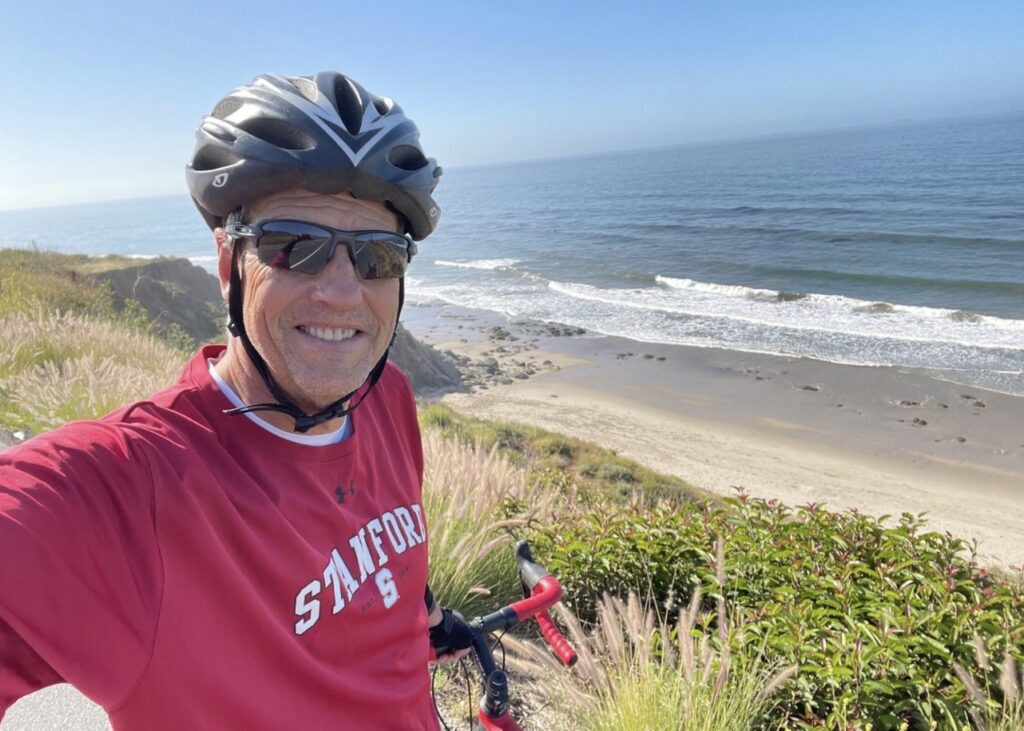
I find myself relating to the dad in The Croods movie, a cave man named Grug. Like me, he loves telling stories and like my family, his family puts up with listening to them. But all of his tales warn of children who left the safety of the cave, or did not listen to their father, and they all end with some version of, “… and then they DIED.” Nicolas Cage is the voice of Grug, and I hope you can hear his voice pausing for effect, then shouting, “… and then they DIED!”
I respect Grug. Who wants their children to leave the safety of the Cave?
Well, I can think of a few people. Let’s start with my parents. They practically shoved me out.
I was raised in a home full of love, but that does not mean my parents didn’t expect me to handle myself safely and confidently when they weren’t around. When I was ten, my parents starting shipping me off to Ozark Boys Camp, a 4-week-long camp in the mountains south of Little Rock. 28 days and nights away from home at the tender age of ten! WTH! But … I loved it. Every cabin was a Major League Baseball team. My first year we were the Cubs. We competed in everything against the other teams – basketball, baseball, archery, rifles, swimming, and more. We played together as we hiked, did crafts, and even water skied. Every Sunday, there was an afternoon church service that everyone attended, except for the twenty or so Catholics. They would load all of us onto a flatbed truck and transport us to the afternoon mass service in Hot Springs. I’m not making this up. By the time it was done, I had a bunch of new friends, and we had all figured out how to survive in a new place with new people and without our families there to tell us what to do or how to do it. The time flew by, I returned dirty, safe, and smiling, and it all showed me once again, that maybe my parents are a lot smarter than I thought they were. They were wise to push me out of the cave, first for small moments, and then for more.
Probably the craziest parenting thing my parents ever did occurred just after I turned sixteen. First, an old man rant: Why in the world don’t kids today want to get their driver’s licenses the minute they turn sixteen? The key to true freedom, or so it seemed when I was that age, was driving and having the ability to leave the cave at sixty miles per hour. Maybe faster. Both of my boys waited until they were well into their 18th year of life before getting their licenses. As a cave-loving dad, I loved their lack of urgency to be free, but I still don’t understand it.
Anyway, about a month after I started driving (which happened ON my 16th birthday), we were eating dinner at the table together when my Dad said, “Mike – I found a summer job for you.” I asked where, and he told me that it was at a hardware store in Sacramento, California. I asked how I was going to get there, and he just said, “You have a driver’s license.” So, I drove two thousand miles, BY MYSELF, from Little Rock to Sacramento, when I was barely sixteen years old. And then I DIED! Actually (and you clever readers know this), I didn’t. I lived with my parents friends (shoutout to at least two Welkers who hosted me and now follow this blog!), earned a little money, and figured out how to manage it. I had a great time, I was too in the moment to be worried, and it was all fine. And I have stories.
You would think I would learn from that, and not be prone to worry like a screaming, maniacal, and over-protective Nicolas Cage/Grug. But I do worry. And even though my boys are 19 and 31, my inner Grug still rages.
My children are better at leaving the cave than I am at letting them go. They love taking trips with friends, sometimes to places that are regarded by some as unsafe. They take on challenging jobs with consequences. They dive into love and relationships. They choose careers I can’t help them with. All of their choices have risks. And to this day, I am fearful that my kids might get hurt in any of those situations. But without those risks, where are the stories? Where is the learning of life lessons? How do we grow? And without taking those risks, there is so much unfulfilled curiosity.
Grug tells a story of curiosity with an ending that surprises no one. “Tonight, we’ll hear the story of Crispy Bear. A long time ago, this little bear was alive. She was alive, because she listened to her father, so she was happy. But Crispy had one terrible problem. She was filled with (pause for effect) … curiosity! (Everyone then gasps in horror.) Yes! And one day, she saw something new … and DIED!”
Even I know that’s a bit much. I love my children’s curiosity and lack of fear. I’m lucky that my boys can’t wait to tell me their stories from outside the cave, about what went well and what failed miserably, just like I still do with my parents.
Our children’s world seems more unsafe than the world I grew up in, but it’s still a world they have to live in on their own. There’s an Eric Church song where he laments about missing his father’s protection that was always in his home growing up. The chorus ends with, “’Cause I’ve learned that the monsters ain’t the ones beneath the bed.” Parents can’t always be there to step between our children and take on those monsters.
There are monsters out in the real world, love, jobs, finances, and other real world stuff, and the best we parents can do is hope that through our lessons in the cave, and by allowing our children to leave the cave well before we are ready, they will be ready to successfully navigate everything that comes their way. But that doesn’t mean I have to like it.
Be safe out there, everyone.
Mike
To get updates on when my next post comes out, please click here.
I hope you all had a nice Independence Day weekend. If I were making the rules, Independence Day would always be the first Monday in July. Actually, I would change the entire calendar. The way our current 7-days-a-week, 365.25-days-a-year calendar is set up, holidays with dates just don’t make sense for working people. Memorial Day and Labor Day got it right, being the last and first Mondays in May and September. But the other holidays need to get with the program. I actually have a new calendar suggestion, but I don’t think America is ready to hear it. Another post for another day.
In any case, Independence, Memorial, and Labor Days are the three holidays where we are all pretty much obligated to cook outdoors or attend an event where the food is grilled, barbecued, or smoked. It’s not a law, but it’s one of those unwritten cultural requirements that is pretty universally accepted. I’m all in by the way. I don’t need much of an excuse to cook outdoors, and I fully accept my responsibility as an American to do so on these three holidays . . . and on at least 97 other days each and every year. In California, cooking outdoors 100 days a year is an achievable and noble goal. Again, I’m all in.
Those of you who love cooking outdoors understand. Ian Knauer from The Wall Street Journal writes that he can’t write about smoking food “without sounding like a romance novelist.” Damn, that’s good. When I see a real writer create true art with their words, I get a little jealous. But I do love it.
I do enjoy preparing food on my gas grill and my Big Green Egg. For those of you not familiar with the BGE, it looks like, well, a Big Green Egg. It uses Japanese Ceramic Komodo technology, and it truly is a world class smoker. I could write an entire ode to my Big Green Egg, but that’s not what this blog post is about.
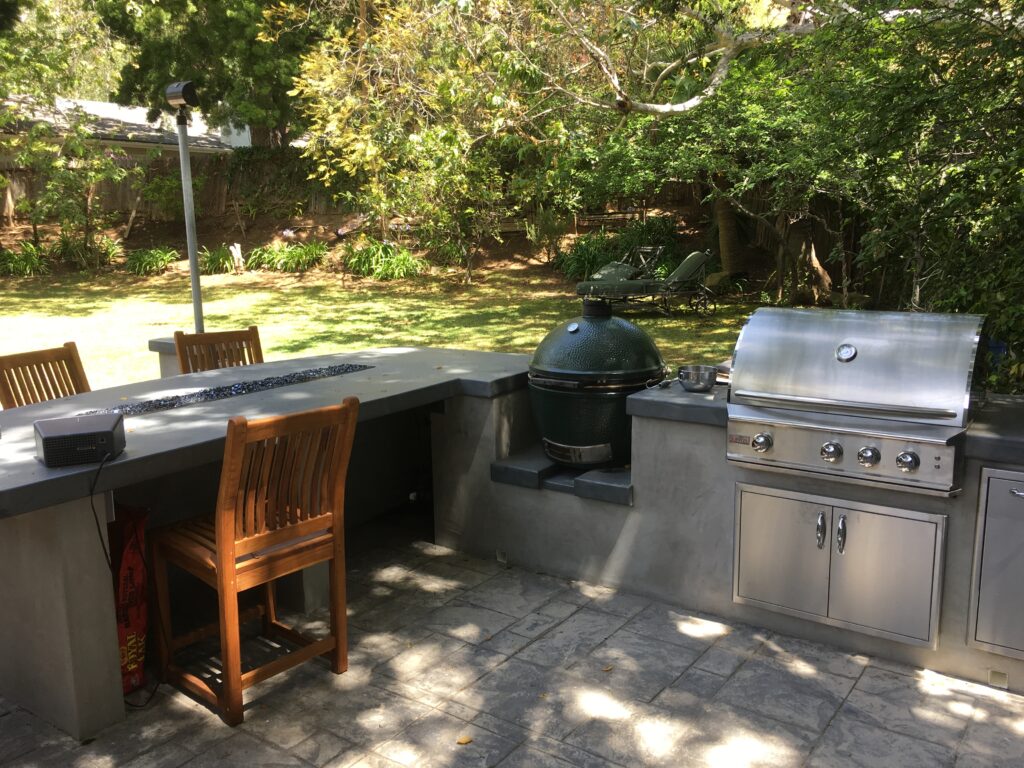
My brother-in-law Will recently got a Big Green Egg for his birthday. His wife Libbie, who is already a rock star in my eyes, gave it to him, and she obviously just went up even higher in the best possible partner competition. Will and I have been talking regularly about his new addiction, and I look forward to our next chat. I already have the same conversations with my son Ryan, another Big Green Egger.
My friend Mark just got a Traeger Smoker Grill. When Mark and I play 18 holes together, we will manage to talk about smoking meat on every hole of our 4+ hour walk. No matter what golf score I get that day, that conversation always makes the day a huge success.
My friend Chris is the best meat smoker I know. He has an old-fashioned offset smoker that requires a great deal of attention throughout the process. I like my Big Green Egg far more than what he has, but honestly, his food comes out absolutely perfect each and every time. He’s an artist who has perfected the art. Nice equipment can make cooking easier, but the true key is having a chef who is a bit fanatical about the process and even more crazy about the result.
While I know plenty of Eggheads (Big Green Egg fanatics) who look down on all other smokers and grills, that’s not me. I remain open minded and enthusiastic about all of the different equipment people use in their outdoor cooking endeavors. I am a better cook because I embrace all differences, and when I see something new, I can’t wait to learn how it might make me better. Anthony Bourdain said it best: “Barbecue may not be the road to world peace, but it’s a start.”
As a host of many backyard barbecue events, and a fortunate attendee of many others, I have developed my own personal rules for attending barbecues. I use the word rules on purpose. They are more than just guidelines. If you break one of them, you are in danger of being that guy. And a good operating goal in life is, never be that guy. I consulted my friends Chris, Mark, and Ben, as well as my son Ryan, on this list, and they all made it better. Here’s what I’ve got:
- Bring something to the BBQ. Drinks are always appreciated. Appetizers are good. If you’re in a pinch, a roll of foil is always appreciated by a true barbecue person.
- Don’t offer advice unless asked. If you see something that you think is being done totally wrong, either ignore it, go away, or tell the chef how great he or she is doing. And, who knows, you might just learn something. Think to yourself, would I tell The Godfather how to do his job? No. No, you wouldn’t.
- Never ever, ever, ever touch the smoker, the grill, or the tools unless asked to do so. Know that if you bring your own meat to the BBQ (not a great idea), it will be cooked by that event’s superintendent of the grill. Don’t offer to flip anything. And if you are even thinking about lifting the lid to take a peek, remember what my friend Chris learned in Memphis, “If you’re lookin’, you ain’t cookin’.”
- Offer to be a taster for the esteemed bbqer. Being there to taste a small cut is definitely a case of being in the right place at the right time, and it’s both a compliment and a recognition of the griller’s artistry.
- Offer to help as a gopher. Be eager to clean up, carry items to and from the kitchen, or serve tables. Don’t hover, but be ready.
- And if you’re hanging out by the grill, don’t crowd the godfather or godmother of the grill. Would you crowd a surgeon? There’s important work going on here folks! Give the chef some room!
Those are my rules. Any other suggestions out there?
Labor Day is coming all too soon, so my advice is to try to grab as many outdoor cooking days and nights as you can until then. We have 57 days of possibility. Try to make them count!
Mike
To get updates on when my next post comes out, please click here.

I have loved not working.
Transitioning from a 60 to 80-hour work week to a 0-hour work week was easier than I ever imagined. I have rested, lost weight and become healthier overall, organized my life, increased my time spent on hobbies I love, and avoided being such a pain that my wife wanted me to return to work. I did not miss work at all.
But I still said yes when a former superintendent colleague asked if I could come support her district for a two-month stint running Human Resources and COVID compliance. My financial advisor has been saying that it wouldn’t hurt me to work every once in a while. While she does not call me lazy, she does point out that I’m still in my earning years, and that every bit helps. Fine, Sonya. I’ll do some short-term stints.
So, I took an 8-week job working for this new district, and . . . I loved it!
I enjoyed meeting new people and becoming better acquainted with colleagues with whom I had only worked from afar. It is a smaller district, and smaller districts are places where there are fewer leaders, and those leaders have to wear a lot of hats. Effectively, all of the leaders have to specialize in, well, everything. And one of the things that I did not know I was missing was the socialization that jobs naturally create. I loved saying good morning to the good-natured and hard-working people in the office, having occasional side conversations, and walking onto a campus just to feel the energy it emanates. Great schools produce spectacular vibes. I think most of us can feel it (or feel its absence) when we walk around a site.
So actually, maybe I miss work a little bit.
My thanks to the outstanding leaders of El Segundo Unified; I am grateful to the teachers, the classified staff, and the administrators for welcoming me and once again proving to me that our nation’s schools do so much good with so few resources. But I did drive more. I played less golf. I worked out a little less. Thus ended Failing Retirement – Part One.
What to do when you enjoy so much about retirement, and yet you still get energized from meaningful work in a profession you love?
When you fail once, I see no other choice but to fail again.
Some of my former teachers, were they to read this, would nod their heads and say, “Same old Matthews.”
But in Failing Retirement – Part Two, I am not taking an eight-week job assignment. This time, I have signed on for one full year, serving as the Superintendent of Schools in the Placentia-Yorba Linda Unified School District. One year is still short-term, right?!? Everyone is clear that I’m there for twelve months, and then I am out after they hire a long-term superintendent for their community. I look forward to a whole series of new challenges, while getting to know and serve the employees and community members who are working together to serve the 24,000 students in this new district.
The past year has been fantastic. I’ve learned that my wife is not totally horrified by the idea of having me around the house almost all of the time. Total win! I’ve learned that I don’t hate not working, and in fact, my life is pretty darn interesting without it. Another win! I’ve learned to be much healthier, and I am way better off for it. I have also enjoyed developing my love of writing, sharing stories, and reflecting on them on my blog site. And our first year of empty nesting has been (don’t tell Ryan and Dawson) nothing short of awesome. Win – win- win!
The number one question for me, beginning on Tuesday, is how do I stay healthier, stay in touch with my hobbies, and keep writing, all while totally immersing myself in a new and fascinating job that will take as much time as I can give it?
I know that, just as many people were intrigued when the wise old owl was asked how many licks in a Tootsie Pop, the suspense is killing most of you. I’ll keep you posted.
To get updates on when my next post comes out, please click here.
Why do I write these blog posts?
There are many reasons. I do love telling stories. One of my beliefs as a parent is that stories create memories. By telling and retelling stories to our children, they become their memories that will shape them or make them smile throughout their lives. My stories become their stories. My awesome mother-in-law and I often begin our stories with, “Stop me if you’ve heard this one before . . .,” and then proceed to march on and tell the story even if our eye-rolling listener has heard it 136 times. I’m OK with that strategy. In fact, I embrace it.
I have stories. I think we all do. And the more risks you take in life, the more stories you have. Being an optimist, I think that all stories can lead to a happy ending. Even the saddest ones. That’s why I keep taking risks, and putting myself out there in the world. That’s why I push myself. That’s why I try to find ways to say yes to new opportunities. After sixty years on this planet, my story closet (I like that term!) is overflowing.
And since those closest to me have heard my stories perhaps a few too many times, it’s nice to find a medium for a wider audience to bear the brunt of my storytelling. I am grateful for those who read, and appreciative of those who comment. I have found the comments to be insightful, humorous, reflective, kind, and remarkably positive. Those are the qualities of my target audience.
I also appreciate the process of writing a weekly post. Sometimes the topic comes to me easily. Sometimes, like this week, I struggle. And the writing itself is quite enjoyable as well. If I’ve thought about it enough, the first draft just flows. I can usually write it in less than two hours. But the most difficult part is the revisions.
It’s never good enough to publish.
Never.
It’s too long. It’s not witty enough. It’s too mundane. The writing is ordinary. I’m not fishing for support here. I’m telling you, it’s just what goes through my head every single time. And it might contain a stupid mistake. I hate that too. And yet I still press “Publish.”
I’m grateful for my three long-time friends who still find time to read my drafts, offer suggestions, kindly point out my errors, and most importantly, reflect on what I’ve written and push me in different directions. It’s an incredibly caring act of friendship, and I never take it for granted. My thanks to them for our enduring friendship and for continuing to make me better.
And in the end, after sweating through the revisions – a process that takes far longer than writing that first draft – I press that publish button and put it out there to those on my mailing list and on social media. Twitter does not work well for me, but I’m OK with that. Twitter may be the meanest place on the planet. I always thought that the bus I took to Central Junior High School in 7th grade was the meanest place, but Twitter blows the wheels off that bus. I know there’s a lot of positive, and I’m grateful to those working to make it a positive place. But it’s too mean for me.
My talented and very funny sister-in-law Tracee is a spectacular artist (that’s her painting of downtown Little Rock above) who excels in using social media to market her creations. We have a text group where we share our successes and failures on the daily Wordle (I love Wordle), and then the comments start. The photo below, taken on April 26, represents perhaps my greatest life accomplishment – guessing the Wordle in one try.
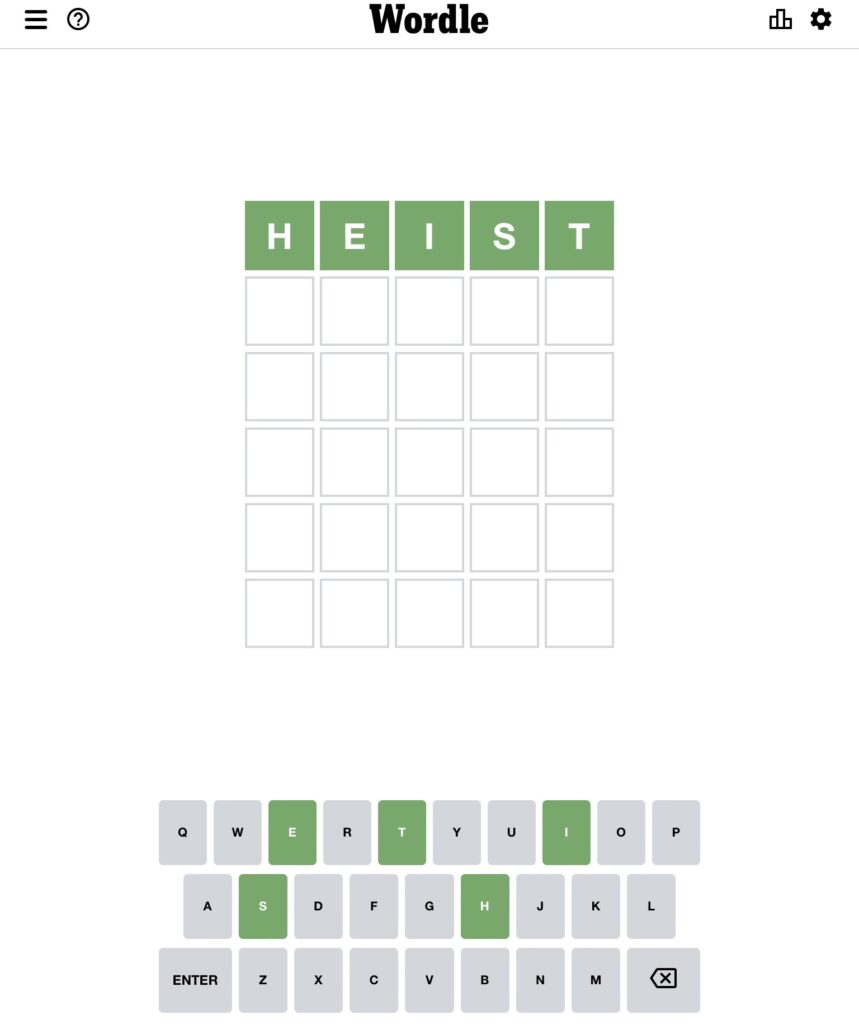
Tracee is the star of those comments on our Worldle text chain, and every day she wins the most comments or most hearts award. We’ve all had to mute the alerts on our phone, as it can be a lot. With my phone muted, I can appreciate the comments a lot more. Anyway, Tracee is one of my role models for effective marketing and social media, and she is trying to make me better. I recently read a book she recommended, Hook Point: How to Stand Out in a 3-Second World.
Some stats that show how challenging it is to catch someone’s attention enough to actually open one of my blog posts:
- The average American sees between 4,000 and 10,000 ads per day.
- There are 60,000,000,000 messages sent out on digital platforms each day.
- We have just 3 seconds to grab someone’s attention enough, to give a clever hook point, so readers will click, open the post, and start to read it. The quality of the post itself determines whether they will actually finish it.
After reading the book, I have determined that not only was I lousy at hook points before reading the book, there is no quick fix, and I’m still pretty bad at it. I could do the old man lament, and long for the older simpler days when only the newspapers and the TV clamored for our attention. But in spite of all of its flaws, and in spite of the 60 billion messages a day (I saw somewhere that if you take out the Kardashians and cat videos, it’s only 40 billion – still a lot) I love the Internet and all of its possibilities. I have to adapt.
I would continue to write for a smaller audience, but I’m grateful for the hundreds of faithful readers that I have. I view the struggle of creating a quality piece of writing as jobs one, two, and three, but I will work on evolving and striving to do a better job of catching people’s interest, because I would love to expand the readership. I will aspire to be more like Tracee, I will continue to learn, and I’ll put myself out there.
Even if I fail, it’s just going to create more stories.
To get updates on when my next post comes out, please click here.
Who says you can’t go home? Jon Bon Jovi sang it, but only as a way to prove that you can. What a fascinating career Bon Jovi had – A Rock and Roll Hall of Famer, actor (he had a great role on The West Wing), and the first rock artist to ever top the Country Music charts with a #1 hit. And to top it off, that hit was about going home to, wait for it … New Jersey! Darius Rucker did it, too. Hitting the top of the Billboard charts with Hootie and the Blowfish, then crushing it as a solo country singer. His cover of “Wagon Wheel” is so popular that many bars have banned playing it on the jukebox. It reminds me of the scene from Wayne’s World where Wayne tries out a guitar at a music shop, starts playing “Stairway to Heaven,” and is quickly stopped by an employee who points to a sign that says, “NO STAIRWAY!” Denied! You can always go home, but you can also play songs too many times.
I have followed Jon Bon Jovi’s advice. and I have been in Arkansas for around a week. While I thoroughly enjoyed many parts of the trip, I needed to be here. I did not need to be here for anyone else; I needed it for me.
I grew up listening to country music. Actually, as the bartender says in The Blues Brothers, I grew up listening to both kinds of music, country and western. We played the Wanted! The Outlaws album a million times in my house, and Willie, Waylon, Jessi, and Tompall continue to be mainstays in my life. When I do something that makes Jill roll her eyes or otherwise question why she sticks with me, I just sing “Put Another Log on the Fire,” and she knows all is well. Over the course of forty plus years in California, my music tastes have expanded wildly – reggae, rock and roll, jazz, and pop punk. But at my roots, there is always Arkansas and country music.
I drafted this blog post early in the morning under the carport in front of my sister Martha’s house in Little Rock, Arkansas. The weather was warm, sultry, but still quite nice in the early morning. By mid-morning, the heat becomes oppressive, requiring my retreat into the air conditioning. But it’s just part of being back where I grew up, where both of my parents, one of my two brothers, and one of my two sisters still live. I’m home.
People hang out in their carports and front yards here. That’s where you’ll see chairs facing the street, ready for parents to sit in and watch their children, for a neighbor to come and visit, or for an odd relative from out of town to sit. And it is in this familiar and comforting spot, faithfully accompanied by my sister’s two aging and loving dogs, that I put my thoughts together for a blog post and say hello to everyone passing by.

That’s a thing in the South. You say hello when you come across people. You look them in the eye, smile, and say hello. When my sister’s neighbors walk by with their dogs or are just strolling by, you say hi and if there’s time, you talk about what’s happening. It feels right. You get to know the security guards and the checkers at the local grocery store, the receptionists in offices, and others in town.
You can’t be in a giant hurry if you have to say hello to everyone. Taking the time to stop and talk with neighbors builds strong relationships, and those bonds create a community that turns your house into a home. And having a home in a wonderful neighborhood, which is exactly what my sister has in Arkansas, and what I have in California, is one way to transition from feeling like a stone tumbling down a river to feeling grounded and connected – it creates a fencepost that helps to define who you are and give you meaning. And the more fenceposts you have in your life, like music, family, and your neighborhood, the more connected and grounded you are.
As I’ve written before, family dinner has always been one of my fenceposts. There is nothing better than simply stopping what you are doing, enjoying a meal, and having a good conversation as a daily fencepost. My swim workouts are another fencepost. They help me to start the day right. Our Monday evenings with Jill’s parents are definitely a fencepost.
I use the concept of fenceposts in teaching, too. If you look at a fence, the most important parts are the posts. Great care is taken to make sure they are sturdy, straight, and firmly connected to the ground. Then the material in between, wood, metal, or barbed wire (maybe one of the most underrated and culture-changing inventions of all time – it’s inexpensive effectiveness completely changed the wide-open nature of the American west), can be slapped up between those posts. If those break, they’re easy to replace, as long as you build and maintain strong fenceposts.
When I teach, I identify the fenceposts that the course will emphasize. There are only four or five in a semester. I’m going to teach the heck out of those elements of the curriculum, so that students have the greatest chance of walking out of that course with an in-depth knowledge of a few key concepts. The rest of the stuff? I’ll teach most of it, and maybe it will spark an interest that a student can pursue later on. Maybe not. But teaching and hurrying through a new topic every day is just asking for that stuff to be quickly forgotten. In teaching, and in life, less rushing and more connecting leads to a richer, fuller experience.
This trip to Arkansas has been about my family fenceposts. My last trip in October focused on visiting old friends. This time, I’ve loved spending time with my mom, my dad (that’s him with me at the top of this post), my stepmom, my siblings, and my cousins. I feel caught up and much more connected. I better understand the health and life challenges that everyone is facing. And being able to sit face to face in order to talk, share, and laugh is something that blows Zoom out of the water.
Even though the heat index has risen over 100 degrees most of the days of my visit, it’s been good to be here. I truly appreciate and marvel at each member of my family. They have inspired me with their positive attitudes, their fortitude in fighting life’s challenges, and their humor in the face of it all. This week was about checking in on one of the most critical fenceposts in my life. I’ve checked the sturdiness and positioning of my family fencepost, and I leave knowing that it will continue to give me strength, meaning, and connection for years to come.
Thanks for reading,
Mike
To get updates on when my next post comes out, please click here.

Thanks for your comments on last week’s post on procrastination. Clearly my journey has been shared by many of you. I decided to re-read the 1994 book from Steven Covey that I mentioned last week – First Things First. I still love Covey’s folksy, sometimes corny, but always insightful and spot-on writing, so I am devoting this week’s post to Big Rocks – one of the core concepts outlined in his book.
I have shown Covey’s Big Rocks video to different groups of teachers and administrators over the years. He challenges one of the persons attending his conference to fit several “big rocks” into a large bucket that is halfway filled with tiny pebbles. He explains that the big rocks are the important things – your career, your family, your physical health, and other important elements of your life. And the pebbles are all of the little things that vie for our attention. As the volunteer tries to make it work, Covey states, “She’s operating on the assumption that by moving things around, we create more space.” That does not work. You have to prioritize the big rocks firsts, then let the pebbles fill in the cracks around those rocks. As I re-watched the video for the umpteenth time, I found that it continues to remind me to be better about focusing on the big rocks in my life.
99% of us struggle to keep the pebbles from squeezing out time for our big rocks. We have to remind ourselves each year, each month, each week, and each day to focus on the big rocks and what is truly important.
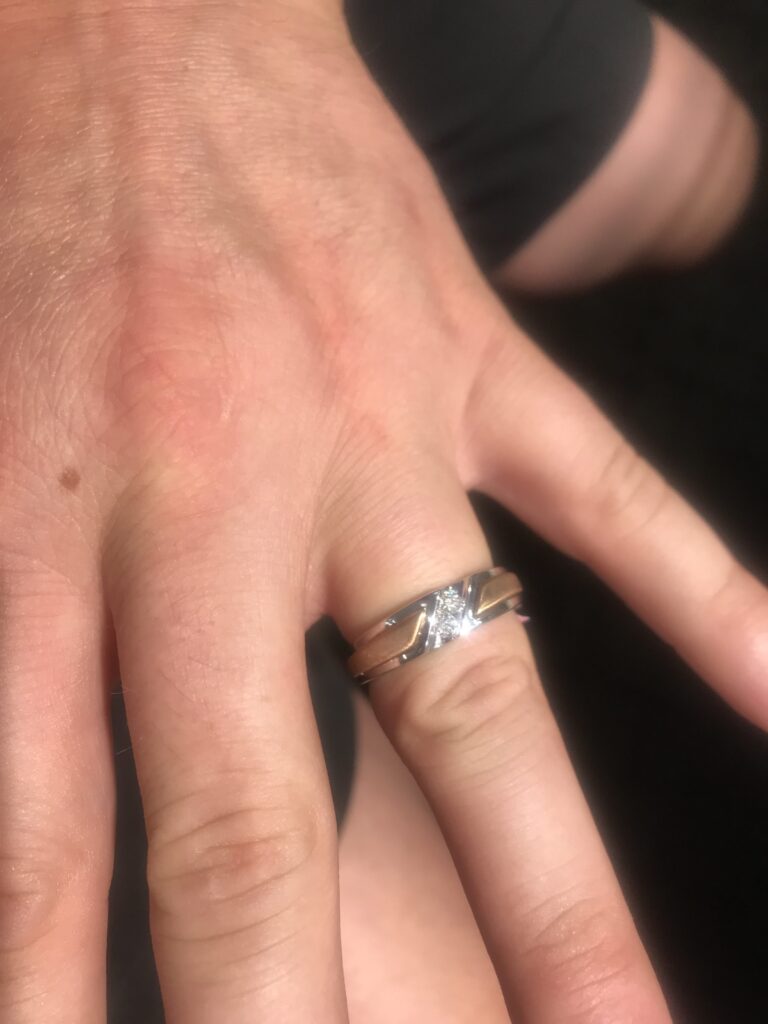
Speaking of big rocks, I am getting very excited about the upcoming wedding in our family. Ryan will marry Yesi in September of this year, and it’s been a long time coming. Damn you, COVID! The details are all coming together. Last weekend they chose a wedding band to match her beautiful engagement ring (and the aforementioned rock), and other details are all coming together. It’s going to be a wonderful event, and I can’t wait! And I’m not even going to tell them to hurry on the grandchildren thing. Caring parents/in-laws would never do that. So even though that would make my family big rock even more precious, I’m going to show a lot of willpower and hold off from even a hint of that thought. They’ll never even know. In the meantime, I love them both, and I love them as a couple, and I am ready for September!
So, how do we focus on those big rocks and keep the pebbles, those smaller, non-important stones, from beating us down with their incessant demands? Another Covey technique is the Time Management Matrix. Covey categorizes all of our to-do tasks into four quadrants:
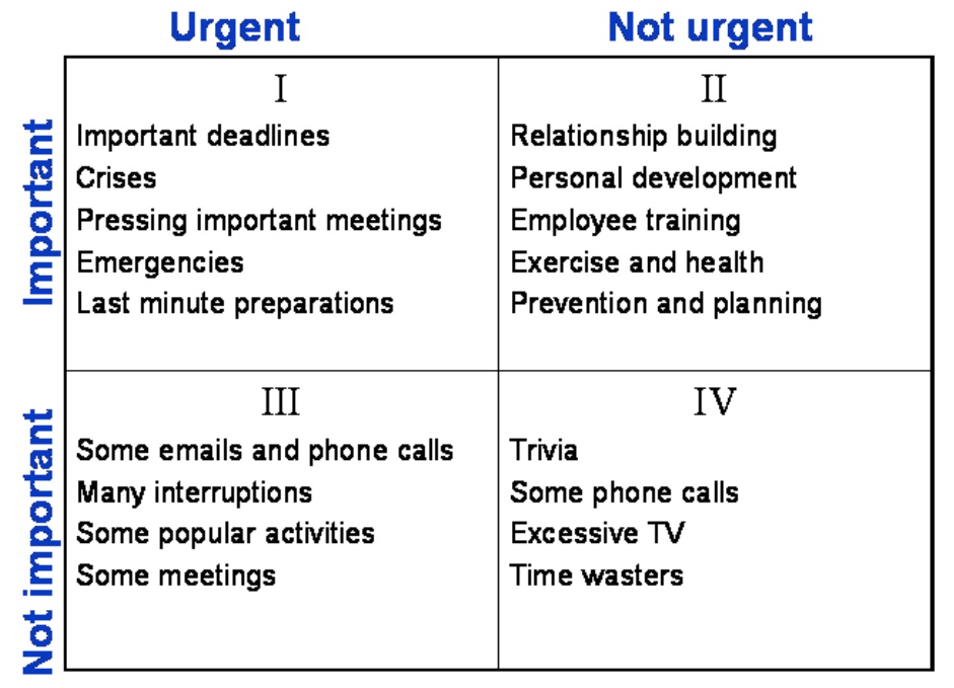
The goal is to spend as much of your time in Quadrant 2 as possible. Quadrant 2 is the non-procrastination zone where we can truly focus on the Big Rocks. Quadrant 1, important and urgent, is the “an unexpected fire just broke out” or the “I have procrastinated too long and now it’s a crisis” zone. You have to do it, but the more time you spend there, the less time you can spend in the calmer and more satisfying Quadrant 2. Quadrant 3, not important, but still urgent, holds the meetings, appointments, or events you “have to” attend. Even though they may not make your life richer, they are obligations and we all have them. And Quadrant 4 is not important and not urgent, and yet these are the tiny pebbles that creep into and can even dominate every part of our life. I need to spend 20-30 minutes a day reading the news and understanding the world I live in. That’s a Quadrant 2 activity for me. But it’s easy to let that thirty minutes creep into much longer, with all of the different media feeds trying to tempt me to waste time in Quadrant 4. Quadrant 4 is always there to distract me, and I have to consciously avoid spending too much time there.
I was in my friend Kim’s office this week, and I saw that she has Covey’s Matrix front and center on her wall. Quadrant Two stares her right in the face every day, and she does what we all need to do – Kim keeps focusing and refocusing on what is important. That made me smile. First Things First reminds us that we have to set time aside each year, each week, and each day to focus on our big rocks, and spend as much time in Quadrant II as we can.
I wrote last week about my bike riding goal, which is still in Quadrant 2 but teetering on moving into Quadrant 1. I have suffered since writing that post, and that’s a good thing. Over 30 miles on Sunday with over 2,500 feet of climbing. Saddle soreness and leg pain tell me I’m on the right track. I’m not going as far as I need to go, and I’m very slow doing it. Quadrant 2 is about steady progress. I’m OK with that. I took the picture above on my way back down into Malibu. It’s easier to smile when you’re descending. Afterwards, I celebrated with a turkey sandwich, some salty Fritos, and a pint of Big Rock Amber, a new beer from the Malibu Brewing Company named after a Malibu beach south of where I live.
After a week of thinking about big rocks, enjoying seeing the picture of the big rock and wedding band that will forever symbolize Ryan and Yesi’s love, and a few strenuous and sweaty hours focusing on one of my big rocks, I got to celebrate with a Big Rock. Literally.
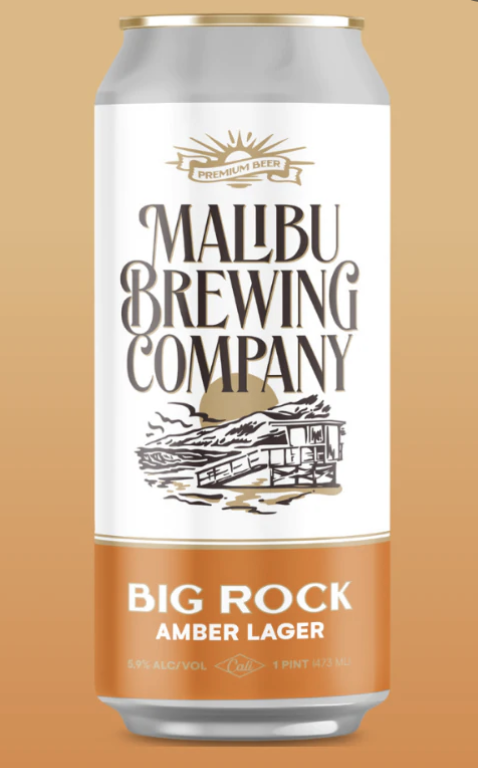
Have a good week.
Mike
To get updates on when my next post comes out, please click here.
I’m WAY less of a procrastinator than I used to be, but I wish I would have started training earlier for our bike trip this summer.
When I was in middle school, I had serious procrastination issues. My science teacher once guided us through a science project for weeks. I remember coming home from school the day before it was due and knowing that, somehow, I needed to compress six weeks of work into one night. So after intelligently spending my afternoon doing other stuff that was not as pressing and consciously choosing to wait until 8:30 in the evening, I finally decided to get started by choosing mold for my topic. Again, this was something the teacher had been telling us to do for weeks. But none of it needed to be done until the final project was due. First step: I asked my mom, “Got any mold?” We went through her bread drawer and through the fridge – nothing! I called my Aunt Alix and asked her if she had any moldy bread in the house. Jackpot! Four or five hours later, after my poor mom drove me over to my Aunt’s house, where we relieved her of the moldy bread (blessed are those who deal patiently with procrastinators), I completed a truly mediocre science project, and earned a not-so-well-deserved B-.
I worked and strived to overcome my procrastination for years, and I’ve been pretty darn successful. On a scale of one to ten, where a one is terrible and a ten is so good that’s it’s almost obsessive, I’ve moved from a three to a solid eight. I’ve read many insightful books that helped me –First Things First, by Steven Covey, Getting Things Done, by David Allen, and The Checklist Manifesto by Atul Gawande are three books that helped me tremendously. I loved my classic-sized leather-bound Franklin-Covey Planner and the calendar and task systems that went with it. I went nowhere without that binder, and it made me better. Covey, Allen, and Gawande all talk about the importance of writing down tasks, prioritizing them, and basing each day on that prioritized list. Air travel and surgery both became safer after checklists became part of the standard operating procedure. For me, the key is starting each day with a checklist of what needs to get done immediately (including having something to check off first thing in the morning – my thing, as I described in my last blog post of 2021, is a perfectly clean kitchen), as well as a list of long-term projects that should be addressed when there is time. And by the way, this kind of organization matters when you’re not working too. If I don’t organize each day, I get far less done than I could through just a few minutes of organizing, even when I’m just spending my day getting things done around the house.
I’m trying to learn to be better from my children’s examples too. Well . . . one of them. I remember watching some sporting event on TV on a Saturday afternoon, when Dawson, my youngest son, picked up his physics book and started working. I asked him if he had an assignment due Monday. He said, “No. It’s due on Wednesday, but I have time now, so I might as well get it done.” (Those are words I never said in high school.) I told my oldest son Ryan about Dawson’s rationale. Ryan’s response was, “Why do it on Saturday when he could probably get it done in two or three five-minute passing periods on the day it’s due? He’s wasting all that time!”
All I want to do is be more like Dawson when I grow up. And to Ryan’s credit, he’s way better than he used to be as well.
I came up with this blog topic on Sunday, during a truly beautiful bike ride along the Malibu coast. It was a 20+ mile ride along the rolling coastline, and I felt like I could have done 30 without hurting. But here’s the thing. By late July, I need to be able to ride 60 miles, or 100 kilometers, without hurting. Every two years or so, we travel with five other couples and take a four- to six-day bicycle trip. Over the last twelve years, we’ve biked together in Nova Scotia, Vermont/New Hampshire, the Finger Lakes of New York, the San Juan Islands, and the Big Island of Hawaii. The picture above is our group traveling down a rarely traveled road on Big Island of Hawaii, and the picture below is Jill and I on a rail trail on the west coast of Nova Scotia. This year, we’re staying a little more local (Damn you Covid! We are not risking air travel this time), and we’ll be biking along the Central Coast of California (Cambria) and over to Paso Robles.
It would have been very easy to start prepping for this ride two months ago, building up slowly over a four-month program. But that’s not what I did, because I still have some procrastinator in me. Now I have just two months. My swimming doesn’t really make my legs stronger, since I don’t kick much when I’m in water. And I also have a Peloton, but my twice-a-week spin simply isn’t enough either. So I’ve got to step it up….and suffer. I’ve written this before, but I need to do what my friend Will says, and “suffer now so I won’t suffer later.”
And unfortunately, because I procrastinated, I’ll have to suffer a little more than I would have if I had not procrastinated. The good news is, there are way worse things than devoting time to bicycling and the painful yet somehow pleasant suffering that comes with getting stronger. And, hey – I still have more than a month and a half to get there! Bring it on. Or, maybe, I’ll wait until next week to really step it up . . . Who needs four months? Four weeks should be plenty!
My lifelong journey of improvement continues.
Mike
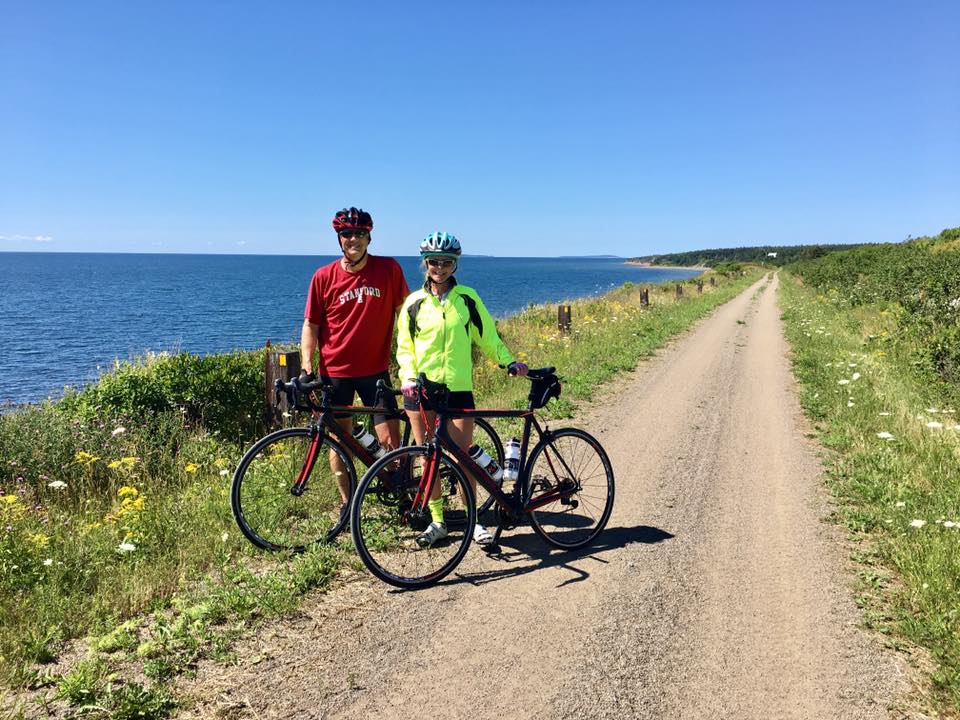
Flags across the nation are at half-mast. Again.
The proper way to put a flag at half-mast is to first raise it all the way to the top, then to pause and bring it back down. The explanation I like best for this tradition is that we bring it down to make room for “the invisible flag of death” looming over a ship, a fort, or in this case, a nation. We have seen our flags at half-mast so often that the flag of death sadly casting its waving shadow no longer seems invisible.
I cannot imagine the pain that the town of Uvalde is experiencing. Just two weeks ago, I wrote about the pain a parent experiences when losing a child. Something that resembles that pain is happening 19 times over in Uvalde. And then there are the two teachers who died trying to protect the children they loved. I’ve been reading about their joyous professionalism – they had families, parents, spouses, and children, all of whom are also suffering tremendously. I feel the survivors’ pain from so many miles away, and I weep for all of them.
We’ve now experienced two mass shootings in one month: The Tops Supermarket massacre in Buffalo, NY, and now the horrific and unfathomable events that took place at Robb Elementary School in Uvalde, TX. The Buffalo shooting was a direct result of white supremacist beliefs and fears. People who are not angered by, or even condemning anything associated with this movements are part of the problem. As Erie County Sheriff John Garcia said, “This was pure evil, a straight-up racially motivated hate crime.”
It’s early to try to understand, but the Uvalde shooting evades comprehension. From early reports, the gunman had a history of anger and bullying, but not a criminal record, nor was there a history of documented mental illness. We will find out more, but I’m not ready to draw conclusions based on how little we know thus far.
I pride myself on being able to productively and calmly dialogue with friends and family who have different political beliefs than I do. I know many who are avid hunters and place a very high priority on gun ownership, as well as gun safety and security. But with most of my friends and family, we are able to find common ground when it comes to a desire for universal and more extensive background checks and longer waiting periods.
I’m with the Golden State Warriors’ Coach Steve Kerr, who would not even talk about basketball when he met with the press before the team’s huge playoff game, as he pushed for a federal law that would require more extensive background checks, urging those who “refuse to do anything about the school violence and supermarket shootings” to take action.
I’m with country western singer Tim McGraw, who said, “Divisive rhetoric has done zero to help this problem – it’s only made it worse. For one minute, let’s set aside our idealistic views and concentrate on the kind of world we want our children to grow up in.”
And I’m with the educators who are reeling over all of this. I have seen several letters from superintendents and principals expressing their sorrow over this latest school shooting (I included one powerful example below), and reminding parents of the dozens of safety measures that have been implemented and built over the last three decades. The employees in the Uvalde Consolidated Independent School District were well-trained and flat-out heroic. Teachers locked down the classrooms and kept students as calm and safe as possible. Today and always, school employees have my deepest respect and admiration for their commitment to school safety. There are dozens of heroic stories that I’m sure will come out of this.
And yet, the school shootings continue.
When I became a teacher back in 1984, I did not think I was signing up to confront murderers with assault rifles. But today, every educator knows that possibility is out there. In spite of that, we educators continue to work in schools, because we love our students, we find purpose in helping our students be the best persons they can be, and we refuse to give up.
My request and hope for all of us is that we do our part, not just with thoughts and prayers, but with a commitment to not let angry dialogue dominate our airwaves, our school board meetings, and our political chambers. My request and hope is that we seek to understand the complexities of these issues, refuse to let simplified political slogans remove that complexity, and work together to solve the problems that lead to a world in which 5-year-olds and kindergarten teachers need to be trained in how to respond to an active shooter – in which any educator or student has to think about the possibility of dying simply because they went to school or work today.
Our children are watching how our nation is solving problems right now, and they are learning the wrong lessons. Even if political rivals do not care for each other or sit on the same side of the aisle, we all share a love for the innocent victims who continue to be killed. I won’t quite go as far as Lennon and McCartney’s “All You Need is Love,” but if we start there, we can be better.
The invisible flag of death will only wave more often if we don’t change.
Mike
To get updates on when my next post comes out, please click here.
My friend Tara is an elementary school principal and a mother. She’s amazing at both. This is what she wrote to her community.
Mass shootings hit harder and heavier for educators. Our training and expertise is in instruction and not combat. Yet, each and every day, we are expected to show up for kids despite the very real fear that we may have to lay down our own lives when we do.
I’m just so sick of it.
Parents, I’m sure you hugged your kids tighter last night. We try our best to shelter our kids from the ills of the world, and yet we are faced with having to tell them what to do if someone is trying to harm them while they learn, play, laugh, and grow. The senseless and spineless act in Uvalde, reminds us how precious life is. My heart breaks for the families that have to feel this pain.
Still, with resilience and strength our teachers and staff press forward, ready to face another day in this profession. Watching you show up every day as beacons of hope and light inspires me each and every day to be your advocate, support, and to continue this job of public service with my head held high.
I will not let the fear and intimidation of the few derail our dreams of changing the world for the many.
To our educators around the world…You showed up today, and I acknowledge you, I feel you, and I applaud you for continuing to be that hope and light for kids.
Thank you, Tara, and thanks to all of the educators who are working to comfort their communities.

Photos by AdamParent and Ronniechua via Pixabay
“Enough with the fruit already!” That’s what my friend Peter yelled at me while we were golfing last week. I had just bitten into my 2nd apple of the round as I was walking down the 12th hole fairway at the beautiful Soule Park Golf Course. I looked at him with his Diet Coke in hand, and I knew he was kidding. But maybe not? He did sound really angry at that apple! But I also realized that I’m a bit of a weirdo for eating fruit as my golf snack. I’m pretty new to the fruit-eating world, and I hope it remains a key part of my nutritional life from this point forward. This week’s post, part five of five on the Blue Zones research on living longer, is all about food. The three nutritional Blue Zones lessons are Plant Slant, Hara Hachi Bu (The 80% Full Rule), and Drink Red Wine in Moderation.
I wrote earlier about my appreciation for the Noom diet. It’s not for everybody, but it helped me so much with the first two Blue Zones rules. Noom pushes fresh fruits and vegetables. Vegetables are nothing but good for us. Fruit packs a few more calories, but it’s super healthy and nothing but good. Noom calls these “green foods,” and urges users to make green foods the centerpiece of their meals and snacks. Noom also steers us away from more dense food, as well as those that are processed. That’s why I started eating apples, grapes, strawberries, and bananas every day. The Blue Zones societies in Costa Rica, Sardinia, and Okinawa have very little access to processed foods or meats. The Adventists eat no meat at all. Over the past year, I’d say that Jill and I have eaten vegetarian meals about half of the time. We eat seafood a couple nights during the week, and I’ll eat chicken or beef once a week. It’s so different from how I grew up. When I told my friend Ben about the awesome Lentil Loaf with onion gravy I had made, he asked me to surrender my Arkansas Native card. Nope. I want to keep that card and have a plant slant. After all, I do still think fried okra still counts as a green food. Quite certain in fact.
The other aspect of Noom that I appreciate is the calorie counting side. Like Weight Watchers, Noom wants you to record everything you eat on the app. Here’s what I learned. To put it scientifically, I used to eat a crap-ton of food. I would say I was choking down 2800 to 3200 calories a day, and wondering why I was exercising so much but still not losing weight. I love food – healthy food, junk food, comfort food, and desserts. I was technically overweight (205-210 on my 6’2” frame), but my height helped hide it. Then my knee doctor said, “You know, it wouldn’t hurt if you lost 15-20 pounds.” Ouch. She called me fat. The Okinawans have their Hara Hachi Bu, which translates to, eat until you are 80% full. My rule had been, eat until you are 105% full and a little uncomfortable, then add a helping of something and/or dessert to complete the meal.
Turns out that’s NOT good for you. Weird right? There are all kinds of tricks to help avoid this – use smaller plates, drink water before and during your meal, make vegetables cover the majority of the plate – but for me most of all, it’s not going back for seconds. So now, I’m consuming 2200 calories a day on average, I’ve gone down a size in my pants and shirts, and I’m fluctuating between 185 and 190. It feels good. And for the first time in decades, my New Years’ resolution was to maintain my weight, not to lose it.
The final Blue Zones rule is to drink red wine in moderation. They cite research on lower rates of heart disease, and cite several Blue Zones societies that do this. Now don’t get me wrong, I enjoy red wine. I am in pursuit of $15 bottles that are nice to drink with dinner. I belong to two wine clubs and it’s nice to occasionally open a special bottle to celebrate something or someone. The key to understanding this rule is that (1) it’s all about moderation, as Blue Zones does advise that going beyond moderation will be dangerous to your health, and (2) it’s optional. Of the nine rules I’ve reviewed, this is the one I’m not pushing hard at all. I know many people whose personal beliefs steer them away from alcohol, and I know too many people who have had their lives almost destroyed by drinking. Not to mention, it’s a lot of dense and sugary calories. A few people very close to me have recently committed to not drinking. I have loved watching them turn their lives around, look and feel healthier, and develop a new appreciation for all that this world has to offer. To go back to the last post, they belong to their AA group and it provides incredible support. So I am not pushing this recommendation, and if you are questioning whether your use of alcohol is hurting your life, listen very carefully to your inner compass.
So that’s it. The end of a five-part series. I’m not sure where I’m headed next, but I’m ready to continue this journey. I’ve enjoyed the process and I appreciate all of your feedback along the way.
Final tip: Chilled Envy Apples – they are the best. I think I’ll bite into one right now. Take that, Peter!
To get updates on when my next post comes out, please click here.

Post #1: Is Retirement the Life for Me? (Blue Zones Rule: Move Naturally Throughout the Day)
Post #2: Is Retirement the Life for Me? (Part 2) (Blue Zones Rule: Know Your Sense of Purpose)
Post #3: In Search of Downshifting, or How to Be More Like My Dogs (Blue Zones Rule: Downshift)
Post #4: Family, Friends, and Community (Blue Zones Rules: Loved Ones First, Right Tribe, and Belong)
Image by Michal Jarmoluk from Pixabay
Thanks to all of you who read my last post on my son Sean. I keep track of how many people open each of my weekly posts, and the readership about Sean crushed everything else I’ve ever written. Your comments and emails were powerful and comforting. As good as it felt to write about it, it was also exhausting. I still feel like I’m in a bit of a vulnerability hangover, but I have no regrets. I’m honored it meant something to so many of you. And, please, you never have to ask if you can share any of my posts. It’s not a diary. IT’S A BLOG! It’s meant to be out there for anyone to read. I would write these posts even if they had a readership of ten. But it’s even better when my efforts matter to others. Please share away.
So once again, thank you!
It’s interesting. If you look at the comments on Facebook and on the blog site, we are developing a bit of a community here. A growing number of you are commenting on my thoughts, and on each other’s too. I love it. And, with a few exceptions, this is a kind group.
So let’s use that segue to get back to my series of posts on living longer – and the next three Blue Zones traits that I want to review are “Loved Ones First,” “Right Tribe,” and “Belong.” All of these are about the people we surround ourselves with, our families, and our communities. I’m grouping them together, mostly because I think if I stretched out this theme too much longer, people might start sticking needles in their eyes. (I have one more next week – on what we should eat and drink to live longer, then I’m done!) But they’re also harmonious because they relate to our social lives, and that has a direct correlation to how well and long we will live.
Loved ones first. It’s about prioritizing family, whatever that means to you.
- Buettner looks at Okinawans, who exemplify multi-generational families being together regularly. We now have a tradition where Jill’s parents come over on Monday night for games and dinner, and stay over until Tuesday morning. Even though they, in my awesome mother-in-law’s words, “put the fun in dysfunctional,” they just add to our craziness, and it’s wonderful.
- For me, it’s about eating dinner together as often as possible. I am a pain in the you-know-what on that one. Let’s sit down and eat together. Bring your friends if you want, but WE ARE GOING TO EAT TOGETHER AND WE’RE GOING TO LIKE IT! (I feel like I yelled that. Sorry.) I did not have to yell about it last night, when I had both of my sons home for dinner for the first time since Thanksgiving. We sat at the table for two hours and it was heaven. Pictures next week.
- I love Buettner’s push to live in a small house. We raised our family in a 1,580 square foot house, not small, but certainly not as big as many, where we NEVER GET AWAY FROM EACH OTHER! (Did I yell that too?). And looking back, I wouldn’t have had it any other way.
- Most of my immediate family lives too far away, but we talk often. It’s not perfect, but we are close, and we make the most of it.
Right Tribe. This is not just about having a tribe, but about having a tribe that supports us in healthy living. Buettner cites Moais (small groups of 5-8 people) that Okinawans create for themselves, and how they exercise, socialize, and support each other regularly. I am member of many groups that matter to me. I have my crazy golfing buddies in Ojai (speaking of dysfunctional!), my early morning swim friends, and the incredible couples and families that live in our little neighborhood. I have my high school friends with whom I’m still close. I have my friendships that I have maintained from all the places that I’ve worked. I feel very fortunate to be a member, maybe not a valued member, but still a member of all of these tribes. Maybe I should be nervous that they let me in. Groucho Marx quipped that he would not want to be, “part of any club that would accept me as one of its members.” But I’m going to ignore that, because I appreciate all of these tribes that I’m in. They make my life better, and I hope to live longer as a result.
Belong. Buettner finds that those who belong to organizations like churches and temples and community groups tend to live longer for a variety of reasons. Why you may ask? Because there’s the social aspect of it, and the positive expectations/codes of behavior that develop among members of groups like these. There’s also the built-in safety net where members care for each other, both every day and in times of need. And of course there are regular gatherings that get us out of whatever we are doing so we can slow down and focus on this group that we belong to. I have been a member of a variety of churches from several different faiths, and of a variety of informal and formal community organizations. Sometimes I felt all that Buettner describes, and sometimes I did not. I’m a free agent at this time, and I’m OK with that. We will see what the future brings.
The bottom line is that the research shows that the world’s longest living societies are populated by people who are connected with others who love and care for them, and that we do better when we are not islands unto ourselves. Every student from my high school tribe remembers that line, as we all had to memorize John Donne’s poetic meditation:
No man is an island,
Entire of itself,
Every man is a piece of the continent,
A part of the main.
If a clod be washed away by the sea,
Europe is the less.
As well as if a promontory were.
As well as if a manor of thy friend’s
Or of thine own were:
Any man’s death diminishes me,
Because I am involved in mankind,
And therefore never send to know for whom the bell tolls;
It tolls for thee.
To get updates on when my next post comes out, please click here.
Image by Gioele Fazzeri from Pixabay
Gravity feels a little more forceful today. Back in my high school physics class, Father Fred taught us that gravity pulls us down at a rate of 9.8 meters per second squared. Today feels like a double-digit day. It’s harder to do just about everything. You see, today would have been my son Sean’s 29th birthday.
Damn.
Many of you reading don’t know this side of me. Answering the “tell me about your kids” question is always a quandary. How deep do I want to go into this answer? It’s easy to talk about Ryan and Dawson. They are wonderful, interesting, funny, and inspiring. I consider them to be my closest friends, and I love them fiercely. But I don’t have two children. I have three.
Sean Michael Matthews was just four years old when he died in a drowning accident on July 31, 1997. This year will be the 25th anniversary of that miserable day. I won’t go into the details, but just know that the feeling of guilt remains, and the heartache is a million times worse.
Many of you reading this knew and loved Sean. Many of you wrapped your arms around Sean’s mom Kelley, Sean’s brother Ryan, and me after his death, helping us all more than you know. It seemed like half of Malibu attended Sean’s memorial service, held in Malibu’s Bluff’s Park – and I barely remember it. Gravity was in triple digits in those days. The pain was searing and truly relentless. All I know is that the love and support helped. I did not read all of the sympathy cards until months after they arrived. And even then, I could only do it for a few minutes at a time. But they were wonderful, and they provided comfort. Thank you. Those acts of kindness made a lasting impact on me. Of all the human attributes I appreciate, kindness ranks at the very top. It’s something I try to include throughout my day, because I know how much it helped me.
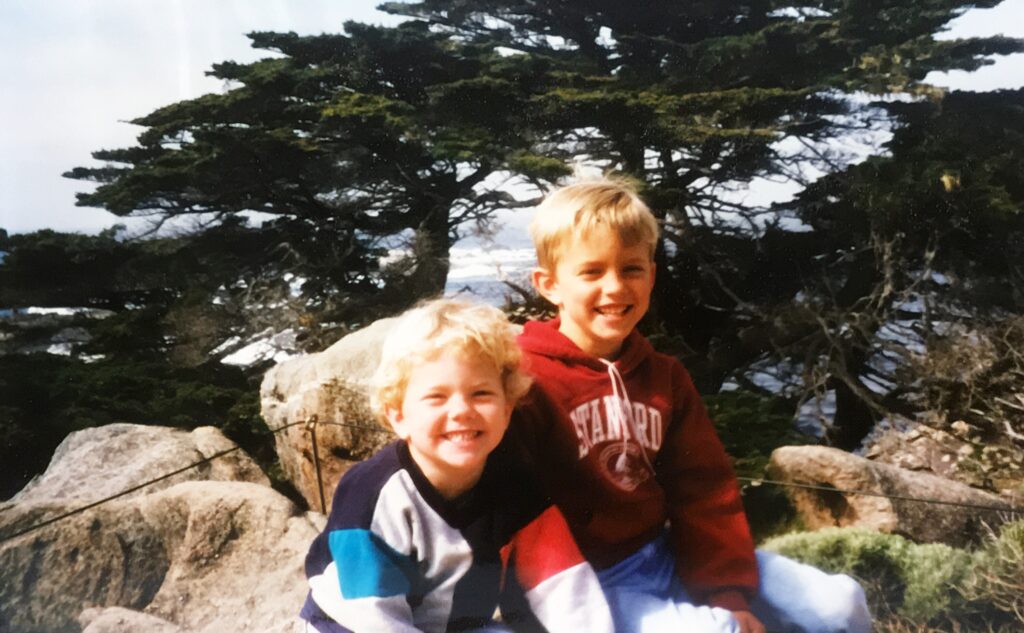
Months after Sean died, Kelley convinced me to join her in attending a support group for grieving parents called Compassionate Friends. I knew that it would not be helpful, because no one else could possibly have experienced anything that rivaled our heartache. But I went anyway, bad attitude and all. It was quite the welcoming group, and as I listened, I realized that I was incredibly wrong. Terrible things happen to people all too often. Heartbreak and anguish are everywhere. You just have to take a moment to listen and notice. The mantra at Compassionate Friends is, “You are not alone.” They helped me to get out of the comparison business. All of this suffering is real, and there’s no benefit or reality to trying to figure out whose pain is worse. I have known a few people whose loved ones died after leading long and full lives, enabling them to be much more accepting of their deaths. But far more common are those who die before they are supposed to, leaving their loved ones to live with the torment of missing them. I’m sorry for all of us. But we are not alone. Others have prevailed, and found strength and purpose in their lives despite their losses, and for whatever reason, knowing that helps me.
The heartache will never be gone. If someone asks me how often it impacts me, 25 years later, I will smile and say, “It’s only every day.” But it is worse some days. Like today.
I remember speaking with a father who had lost his son in a senseless shooting at least 20 years before our conversation. I asked him what the pain felt like so many years later. He said that it was still there every day, “but it is softer most of the time.” A few years ago, Kelley posted a picture of a sculpture on Facebook that took my breath away. The hole in our grieving hearts never fills, and we will never be whole again.
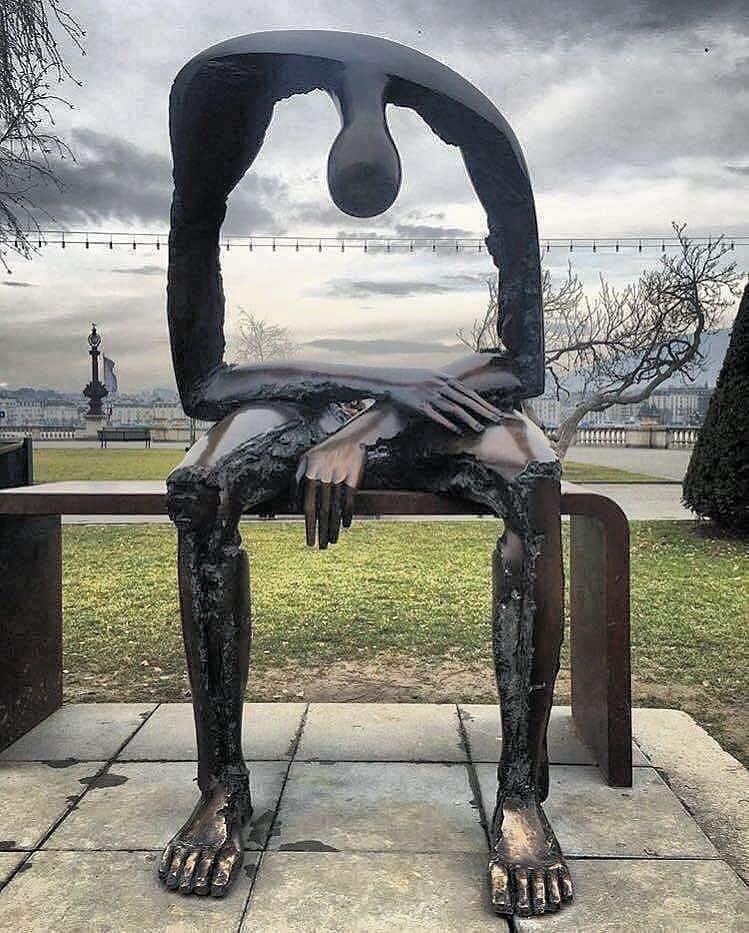
Love is the greatest risk of all. There are no guarantees beyond today. While I was Superintendent in Manhattan Beach, one of our most beloved teachers at Manhattan Beach Middle School was one of the people tragically killed at the Route 91 Music Festival in Las Vegas. Her name was Sandy Casey, and she taught some of our most impacted students. She had a saying: “Today is a good day for a good day.” In the wake of our loss, we remembered those words, and if you look around, you can see that saying written in cursive on doors throughout the school district. Sandy continues to teach us to find ways to make the most of each day. I love it. As Brad Paisley sings, “Bring on tomorrow, I’ve got today.”
In those first few years after Sean’s death, I wondered about how the rest of my life would be. Would it ever feel normal again? Well, the answer is no. I miss his laughter, his spirit, his loving nature . . . I just miss him so much. But what still is surprising to me is that the answer is also that I am continually amazed at how beautiful and wonderful life is. In spite of everything. I am beyond grateful for the love, humor, meaning, and beauty in my life. And in spite of gravity pulling me down with more force today, I’ll do my best to remember that it’s still a good day for a good day.
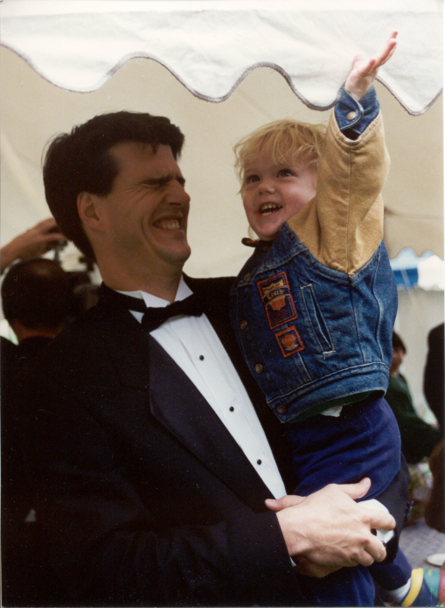
To get updates on when my next post comes out, please click here.
Notes
The sculpture above is called Melancolie and is created by Albert György. It can be found in Geneva in a small park on the promenade along the shore of Lake Geneva. Read more about the piece and artist here –> https://totallybuffalo.com/a-sculpture-that-creates-intens…/
My first two posts in this series on living a long and healthy life focused on moving naturally throughout the day and holding a strong sense of purpose. This week and for Part 3 of this series, I am focusing on downshifting. The Blue Zones research suggests that people in the longest living societies find serenity on a daily basis. The Nicoyans of Costa Rica, like people in many societies where the weather is extremely hot, rest each afternoon. The Seventh Day Adventists in Southern California’s Inland Empire create a “sanctuary in time,” halting activities from sunset on Friday to sunset on Saturday. The lesson is that this downshifting, resting, and stepping back from the craziness of life helps us to live longer and better.
There’s more and more science about the restorative and regenerative powers of sleep and rest. Most of the world’s best athletes are outstanding downshifters, making extraordinary time for recovery, especially when they need to be at their best. Researchers say that rest tamps down inflammation that impact all of us, and getting enough of it promotes the health and longevity of our muscles, joints, and even our brains.
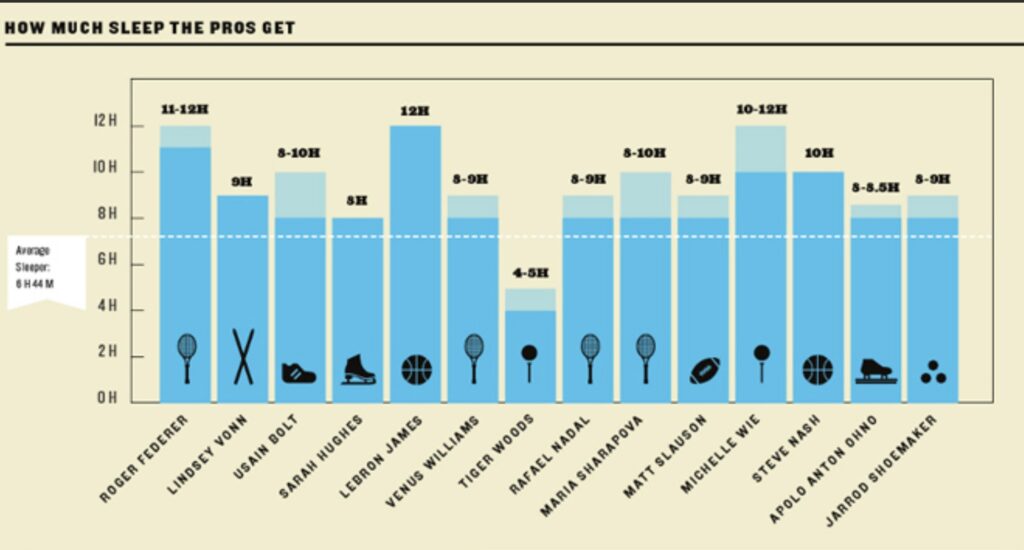
My dogs are amazing downshifters. I mean, they spend 80% to 98% of their day in a fully downshifted mode. We adopted our two Scottish Terriers (Duffy and Maggie Mae) almost two years ago (raise your hand if you too have a COVID dog/cat/something), and they have been a great presence in our life. They look like toppled over Monopoly dog pieces when they are downshifting, which I still find hilarious. And they need that energy to gobble up their food faster than contestants at a hot dog eating contest, so they can lose their minds with a barking bonanza whenever the mail carrier or Amazon person approaches our door, or to give futile chase to the squirrel that torments them daily in the backyard. If downshifting is the key to a longer life, they are going to live to be 30,000 years old.
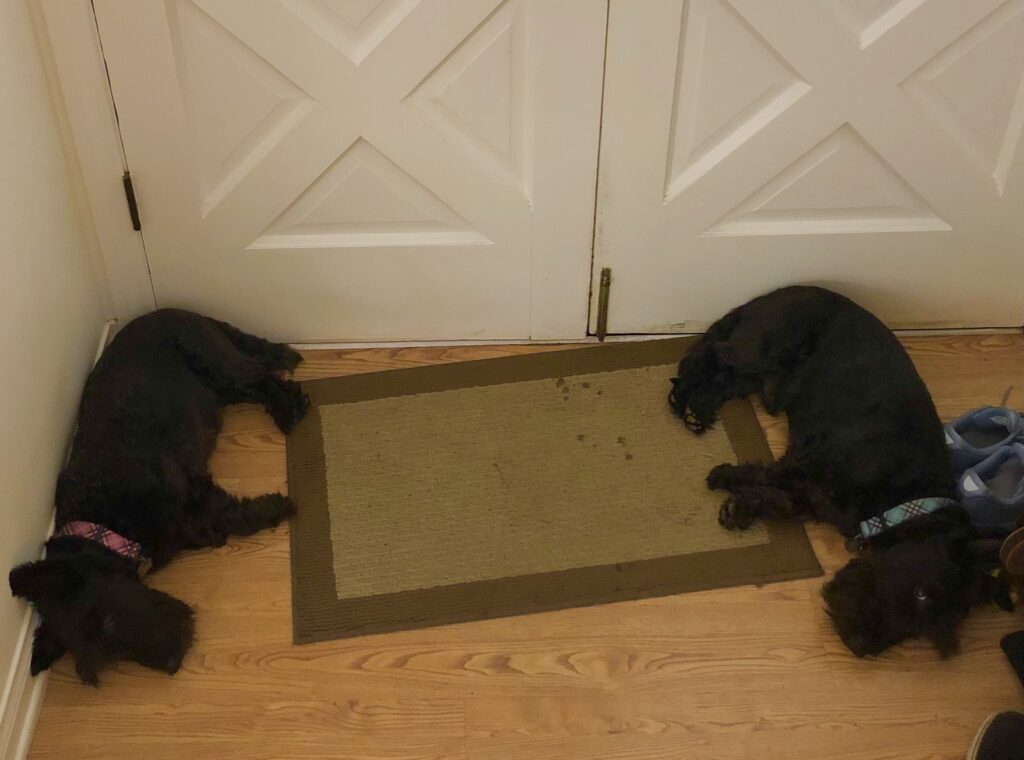
I’m not even close to being as good as my dogs at this downshifting stuff. My idea of a fun vacation is to wake up early, do tons of new and exciting things, wear myself out, and do it all again the very next day. The only reason I’m not a total zero is because I love a 20-minute nap. If I can sneak in a short power nap, I am way better in the afternoon, and I might even stay awake past 9:00 at night. Crazy! But 24 hours of downtime? Sleeping more than six hours? Meditating or just being? While I’m not giving up, it has not happened for me yet.
My job as a teacher, principal, and superintendent took as many hours as I would give it. Ask any teacher or administrator – no matter how many hours you work in a week, it’s not enough to do everything that needs to be done. To stay somewhat healthy, you have to make a conscious decision to stop working at some point and pivot to the equally important job of taking care of you.
But downshifting is critical. Most of the time, my version of downshifting was just not doing work. When I came home at night – it might be 6:00, 7:00 or 10:00, I tried to be off email for the rest of the evening. There were emergency exceptions, but I worked to be present at home and not to have my head back at work for those few hours, or minutes, before going to bed. And on the weekends, I always tried to make Saturday a non-working day. By Sunday afternoon, I had to get ready for the week, but my goal was to enjoy a good 24-36 hours without working.
But, I wonder if I was actually downshifting in that time. Unlike my dogs, I spend most of my non-working time being active – cooking, golfing, doing something with the family, cleaning or organizing the house, exercising, and maybe watching a movie or sports event on TV. Do those count as downshifting? Are those activities fighting inflammation and making me healthier?
Robbie Shell from the Wall Street Journal wrote an article that hit home when he said, “One of the major joys of retirement has been the luxury of spending more time on those things I look forward to doing, with no deadlines to rein me in, no obligations that require me to make those hard choices about how to spend each day.” I’m not sure if this counts as downshifting, but it is an improvement.
One area where I may have made a little progress is my purposeful effort not to rush from one activity to the next. Athletes sit on the bench between quarters. My dogs sleep for about four hours between their activities. Over the last few months, I have learned to take a moment, relax, and actually get ready for whatever is next. I wish I would have done that more at work. Too often, I went from meeting to meeting to meeting, never pausing to think about next steps, to recover from a challenging conversation, or to just step away from the mania. I thought I could do all of that when the day was over. But now, I am allowing myself more transition time instead of rushing like a transitioning triathlete between the swimming and biking segments. And I can honestly say it definitely makes life a lot more sane.
I’m also working to follow Shell’s advice and give myself permission to take more time while I’m engaged in what I will call a downshifting activity. Again, I’m not sure if this meets the Blue Zones definition of downshifting, but would be progress for me. My friend Karen made a spectacular dinner for us a few weeks ago, and told us she had spent the entire day cooking and she had loved every minute of it! That has to count as downshifting, right? If I have the time, I want to give myself the luxury of not rushing to cook dinner. After a wonderful night at a restaurant with friends recently, my friend Kevin lamented that he wished we would have ordered dessert and coffee. He didn’t really want dessert (I always want dessert), but he enjoyed the conversation so much that he wished he had used that excuse to prolong and luxuriate in the experience. That has to be a downshifting mentality too. Right? For now, I am declaring it to be so.
Ultimately, I seek to be more like Duffy and Maggie Mae in my mastery of downshifting, but I have a long way to go. Wish me luck.
Mike
To get updates on when my next post comes out, please click here!

Sources:
Fast Company: Why Pro Athletes Sleep 12 Hours a Day
Shell, Robbie. “Taking My Time is One of the Pleasures of Retirement.” Wall Street Journal. April 17, 2022.
Buettner, Dan. The Blue Zones: Nine Lessons for living Longer from the People Who’ve Lived the Longest. National Geographic Society. Washington, DC. (2008).
Other Notes: Sections I Cut Out to make this post just a little too long instead of way too long.
First of all, thank to all of you who read and commented on my last post via Facebook, Twitter, and the Blog Site. I love the conversation and I appreciate the wisdom even more. This is Post #2 of Evaluating my Quasi-Retired Life using Dan Buettner’s Blue Zones research. As a reminder, the nine Blue Zones recommendations for a longer, healthier, and happier life are:
- Move naturally throughout the day
- Know your sense of purpose
- Downshift every day to relieve stress
- 80% Rule: stop eating when you are 80% full
- Plant Slant: Make beans, whole grains, veggies, and fruit the center of your diet
- Red Wine in Moderation: Enjoy wine and alcohol moderately with friends and/or food
- Belong: Be part of a faith-based community or organization
- Loved Ones First: Have close friends and strong family connections
- Right Tribe: Cultivate close friends and strong social networks
Just a little recap on #1 – Move Naturally, which I addressed in my last post. My friend Ben reminded me that part of moving can be pushing yourself to extremes. Ben retired the same time I did, and has just put out a new podcast series called Fear of Retirement. In the second episode, Ben goes into his version of movement, which is super intense and maybe not for everyone. He reminds me that it’s always good to have BHAGs (Big Hairy Audacious Goals). I agree with this – so, while I’m getting more steps in by walking and golfing, I’m also working on some BHAGs. For me, one of them is swimming in my sixties as fast as I swam in high school – or maybe just fast enough to beat a former student who is challenging me to a 50-yard sprint. (Whenever you’re ready, Brad.) For Ben, it was benching over 300 pounds (mission accomplished). It’s a great listen, and I bring it up just because there are so many ways to move, and we can all find our way to meet this goal. And not to brag about being semi-famous, but Ben gave me a shoutout in the 2nd episode. While not mentioning my name, he referred to me as a “psycho.” Thanks, Ben. I love you too.
Let’s move on to Blue Zone recommendation #2 – Know Your Sense of Purpose. After identifying the six longest living societies in the world and describing how they live their lives, Buettner writes that two of these societies, Okinawans and Costa Rica’s Nicoyans, have cultures in which individuals know “why I wake up in the morning” (Okinawans call it ikigai and Nicoyans refer to their plan de vida.) Let’s face it, we need to have some sense of purpose that we look forward to when we start each day. I love that, because one of my many annoying habits over the course of my life is that on top of being a poor sleeper (side note, this has not gotten better since leaving work), when I wake up in the morning, I am AWAKE and I am ready to go. There is no grogginess, and I am ready to carpe that diem.
As I think back, purpose was easy to come by in my life before this retirement phase. I was fortunate during my 30 years of raising children in our home and my 38-year career in education to have a life that was filled with a massive sense of purpose. Between all that it involved in parenting beginning in 1990, and providing our youth with a high-quality education starting back in 1984, I jumped out of bed every morning knowing that I was making a difference. Yes, every day held its challenges and triumphs, interspersed with many great moments, but I always knew that what I was doing was important, and potentially life-changing.
But, there is a danger in that too. I have watched people retire and come back looking ten years younger and smiling bigger than ever. They have cultivated more reasons for getting out of bed than just work. They have hobbies, passions, friendships, and many other reasons to look forward to each day. On the other hand, I have seen people whose whole sense of purpose was linked to their job. They might have been outstanding at work, but they did not fare well in retirement. So my strong advice is to find a sense of purpose outside of your professional world.
Dan Buettner writes that purpose can come when you can find flow on most days of your life. I love the research on flow. I wrote about it in a post back in April of 2020. If you have moments throughout your day where you experience flow, when you are so immersed in whatever you are doing that time ceases to have meaning, that alone is worth waking up for. Some of my best flow-producing activities are problem-solving, teaching, swimming, golf, playing music, and yes, even my morning ritual of making the kitchen look perfect for the day. It’s amazing how many times this concept keeps popping up into my life. Flow does make life worth living, and according to the research, it gives us improved odds for living longer and better.
And before I go any further, this is not a “check all of the boxes” list. That’s crazy and unrealistic. This is a “there are so many different reasons people have for waking up with purpose, what’s yours?” list.
Other reasons for waking up each day include knowing that you are making a difference. My friend and blogger mentor Chris Erskine is finding purpose being a grandfather. Learning something new provides outstanding, interesting, and brain-building motivation for life. And as my friend Pam wrote in the comments of my last blog post, it’s never too late to learn how to live better. Engaging in new and complex activities requires immersion and can also lead to flow. Even gratitude for what you have provides more purpose than any of us actually realize. (Note – this paragraph could have been dramatically expanded, but most of my blogs are too long already, so just know there’s a lot that could be delved into for each the bolded topics.)
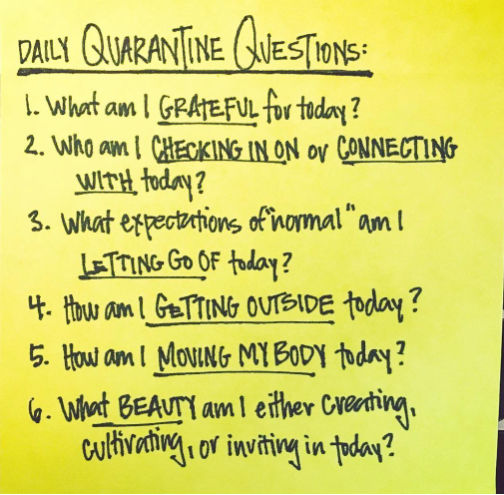
This is a good time for me to ponder this critical question of having a strong sense of purpose in retirement, as I am taking a pause from all of this retirement bliss and working for two months helping out a local school district. More on that in a future post, but for now, I am asking myself whether immersing in more flow-inducing activities and the increased opportunities for thinking, writing, and learning are sufficient to replace the overwhelming sense of purpose I had while working in public education. So far, the answer is strongly affirmative, but there are many ballots still to count, and I’m not making any projections yet.
My next blog post will be on flow’s less purposeful yet equally important counterpart – downshifting.
Thanks for reading!
Mike
Note: The picture at the top of the post is of the mighty Kings River in Central California at sunrise. Between getting up early and loving to cook, one of my jobs at a four-day river floating/camping/game-playing trip that we took every year with 100 of our closest friends was to wake up each morning to cook breakfast for everybody. I always took a pause at the river before I headed up to the outdoor kitchen to make the coffee and start working through frying 40 pounds of bacon. As I said, waking up has always been easy for me, and witnessing beauty like this makes it even better.
To get updates on when my next post comes out, please click here!
If you started singing the theme song from Green Acres when you saw that title, you may (1) way too impacted by afternoon tv in the 1970s, and (2) also be considering this question.
August 31 was my last official day at work in my job as a school superintendent. For almost eight months, I have had no official job. Like I wrote a while back, the last time I had this kind of free time was back when I dropped out of college to be a street musician. But even then, I “had to” go to work in the evenings to make enough money to eat and pay rent. (Also, as the picture above proves, my street musician life provided me with critical skills for my teaching and high school principal jobs – like performing for Sixties Week.) Still, it was a lot of free time, and it was an outstanding period in my life. Now, for just the second time in my life, I have that kind of free time again.
I am devoting this blog post to reflecting on and evaluating my level of happiness with my newly-found free time in this new phase of my life.
A big motivator behind my decision to retire was to do what was best for a long and healthy life with my friends and loved ones. While I loved my job as a school superintendent, it could be crazy at times. A big part of my job was to get yelled at. That yelling could come from angry residents, dissatisfied union leaders, or any number of constituents. And though it was not constant, it was increasing in frequency. Public schools are bearing the brunt of the same anger that is plaguing (and harming) national politics. When I encountered that yelling, my job was to imitate Kevin Bacon in Animal House, responding with the equivalent of “Thank you sir, may I have another,” and to do so with a smile. I did that quite well for a long time, but it took its toll.
But there were other reasons. I commuted 41 miles each way for eleven years. My work week, including commute time, ranged from 65 to 80 hours a week. I was away from home at least two evenings every week, and often up to four. (High school principals are out even more!) My weight had gone up a little, and for the first time in my life, my doctor had some concerns about what the stress was doing to me. And, eleven years is a long time to be in one job. I was also a successful high school principal for eleven years, and at the end of both of those tenures, I just felt it was time to go, even though I loved the job.
All of that being said, I loved my job as superintendent. I worked with a fantastic board, and benefitted from their wisdom, care for students and employees, and humor. My colleagues were an amazing team of leaders with whom I was proud to work side by side. I was inspired by the employees and students that I served, and I was overwhelmed by the generosity and support of the vast majority of parents and community leaders. In spite of being ready to leave, it was hard to leave all of those positives.
So, it’s time for me to reflect on how it’s going, and whether or not it feels right and whether what I’m doing now is going to help me achieve my goals of happiness and a long life with friends and loved ones.
The bottom line: Not working has been awesome. I am busy, Jill is happy with the changes she’s seen, and I know I’m healthier. My newly-found free time, just like it did back in my street musician days, truly helps me to center myself and find balance.
My only concern is that I do miss the human interaction. When I worked, I was rarely by myself. As I often said about my job, I made a living running or being in meetings. I was always talking with people, and most of the time, I loved it. Now, there is down time and quiet time. There’s a lot of good in that, and yet, I am still thinking about how to achieve that balance of the right amount of human interaction.
In order to further investigate whether this new lifestyle of mine is going to help me live longer, I will break it down using the Blue Zones research of Dan Buettner. Blue Zones looks at the lifestyles of communities where people live longer, healthier, and happier lives than other areas of the world. Based on their research, Buettner makes nine recommendations for all of us to strive for in our lives:
- Move naturally throughout the day
- Know your sense of purpose
- Downshift every day to relieve stress
- 80% Rule: stop eating when you are 80% full
- Plant Slant: Make beans, whole grains, veggies, and fruit the center of your diet
- Red Wine in Moderation: Enjoy wine and alcohol moderately with friends and/or food
- Belong: Be part of a faith-based community or organization
- Loved Ones First: Have close friends and strong family connections
- Right Tribe: Cultivate close friends and strong social networks
It’s good stuff, right? Very commonsensical, and not at all extreme or crazy. Over the next few months, I’ll break this down into two or three blog posts that discuss how I’m doing in each of those areas, and how it compared to when I was working full time. For this post, I’ll just hit the first one – move naturally throughout the day.
Blue Zones Lesson #1: Move Naturally Throughout the Day: GIANT CHANGE! And all of it good. I’m driving (and sitting) way less. I’m walking a golf course twice a week. I’m walking in my own neighborhood. I’m moving around the house. Whenever I’m home at lunch while Jill is working, I’m busy in the kitchen making her lunch. My steps per day on weekdays have gone from 4,000 to a range of 9,000 to 20,000. When you meet for a living, you sit and sit and sit. It’s a killer. Between walking around the house, swimming several times a week, playing golf, and Pelotoning/biking, I’m moving so much more than I have in a long, long time, and it feels right. So I’m 1/1 in the Blue Zones research so far.
For those of you who say you hate me when I discuss how good this has been, one of the questions I am asking myself is whether I could have done a better job of this while I was working. I’ll address that in these future posts. There’s more to come, and I look forward to this process.
To get updates on when my next post comes out, please click here!
Jill and I returned home today from our Hawaiian vacation. I’m a big fan of our 50th state. If I feel far away from reality when I’m 26 miles across the sea on Catalina Island, imagine how distant I feel in Hawaii! Really distant is the answer. Even in quasi-retirement, being home means routines and responsibilities. Those all seem to melt away on a great vacation. As my friend Will says, there’s just nothing to do, and all day to do it.
Neither Jill nor I are fans of doing nothing while we are on vacation. Jill seeks out more relaxing activities, while I prefer day trips and seeing/doing what I think needs to be seen and done, but we both agree that vacation is a perfect time for games. I used to think I loved games until I met Jill. Jill’s vibrant passion for games makes my enjoyment look my old mid-size Honda Ridgeline next to Jill’s new massive Dodge Ram 1500. Disirregardless, I have long loved passing time while playing games.
My family used to vacation in Lake Ouachita (If you don’t remember, it’s pronounced Wa-shə-taw – and any day I get to use a schwa is a good day!), which is about an hour’s drive south of Little Rock, Arkansas. Our strategy was to get down to the lake on Friday afternoon, load up the ski boat, and head out to lay claim to one of the lake’s many islands. We would set up camp with a few other families and friends, and spend the weekend just hanging out. The main activity on the lake was water skiing early in the morning and late in the afternoon, when the water was as glassy as possible. There was also inner tubing behind the boat, and three meals a day. But other than that, there was a lot of down time filled with hot humid air and lake water that was not much cooler. So, what to do?
While there were always some board games, my favorite game had no board and was always played with Kent and Kirt Hyde. We would be sitting in lawn chairs, and in a slow voice, I would say, “Mr. Hyde, I’m pretty sure I can take this little rock right here, make a perfect throw, and hit the top of that tree stump.” For the next hour or three, there would be a lot of talk about the previous throw, then a lot more talk about how each of us was going to outdo the last throw. It was a less-skilled and more trash-talking version of the old Larry Bird – Michael Jordan “Nothing But Net” commercials. And it would last for hours.
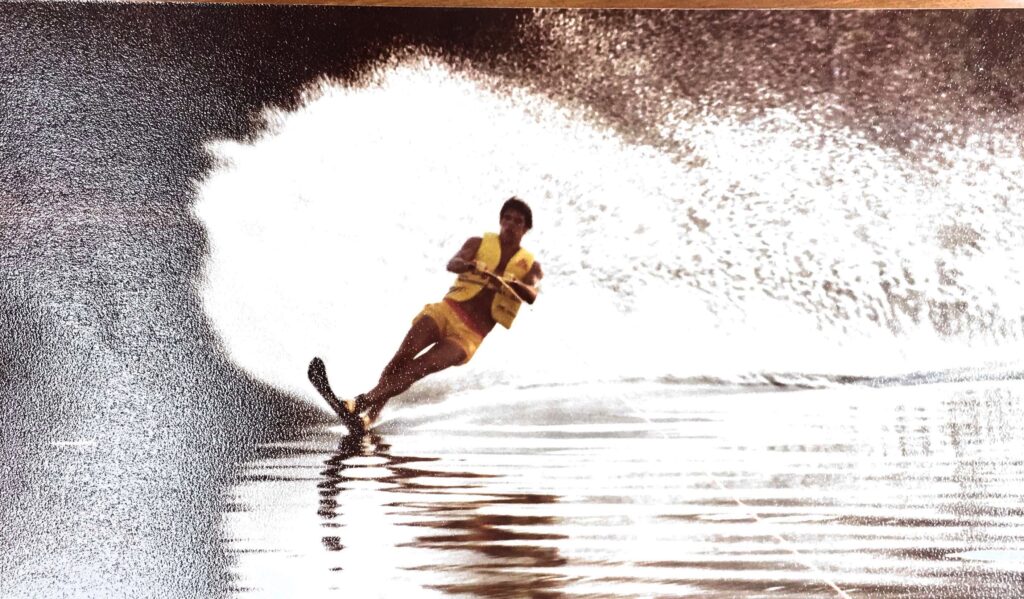
When time doesn’t matter, games are a wonderful way to pass it. Great games involve varying degrees of skill, strategy, competition, and the opportunity for enjoyable conversation. I think games are far more enjoyable when you don’t hate losing. For me, I love to win, but though I won’t say I like losing, I love playing a lot more than I dislike losing. (Side note: For all of you who dislike losing more than you like playing – you’re not that fun to play with.) Over the last 25 years, I’ve played ping pong for hours with both of my sons in our back yard. Playing, talking, laughing, and always getting better. Even though my son Ryan now beats me in 19 out of 20 games in ping pong, I still love playing with him. It’s my own fault he’s so damn good. For years, because his backhand was weak and I wanted to win, I hit him nothing but backhands. Now, his backhand slam is vicious. And he still holds a lot of anger about all of those backhands I fed him, which I can always feel as the ball whizzes past me as he wins yet another point. And still, I love to play the game with him.
When time doesn’t matter, games are a wonderful way to pass it. Great games involve varying degrees of skill, strategy, competition, and the opportunity for enjoyable conversation.
During this time in Hawaii, I played a lot of golf on a beautiful course. I don’t believe there is a better game for scenery, strategy, conversation, competition, and skill than golf. I’ve played a good amount of cornhole as well. Cornhole was not around when I was a kid, but I’m sure it was inspired by experiences like my early rock-throwing contests with Kent and Kirk. It’s a spectacular game that, unlike golf, any yahoo can play. To add to the mix, Jill and I played more than a few hands of cribbage – I’m now ahead by just one game in our lifelong tally of wins. It’s closer than I would like. We met another couple in Hawaii that loves games, and while playing table shuffleboard, we learned we all love Rummikub. So we bought a set and played that for two nights. We suggested a third night and they gave us a wide-eyed but polite hard no. I know. We can be a bit much when it comes to game-playing. We met four other people who were playing “Crud” on a pool table – they taught us how to play, and now we are fans of Crud. Lots of moving around and laughing in that one. Suffice it to say, game playing was a HUGE part of this amazing vacation.
As I mentioned, game playing creates one of my favorite settings for conversations. It’s way better than my least favorite form of conversation – the cocktail party/visit in the parlor conversation. Maybe I don’t like those types of conversations just because I’m not that good at it. In those settings, the only thing we have to talk about is what we are talking about. But if I’m cooking, or the person I’m talking with is cooking, or if we are enjoying a meal, or if we are playing a game together, or walking or hiking together, or just DOING SOMETHING BESIDES TALKING, there are boundless conversational options, and I am all in and I can’t get enough of it.
I know when we get back home, the games won’t be as constant, but they will still be a fantastic part of our lives. So to celebrate games and all the ways they enrich our lives, I think I’ll go outside and throw a few rocks or cornhole bags. Just for practice.
Have a great rest of the week,
Mike
To get updates on when my next post comes out, please click here!
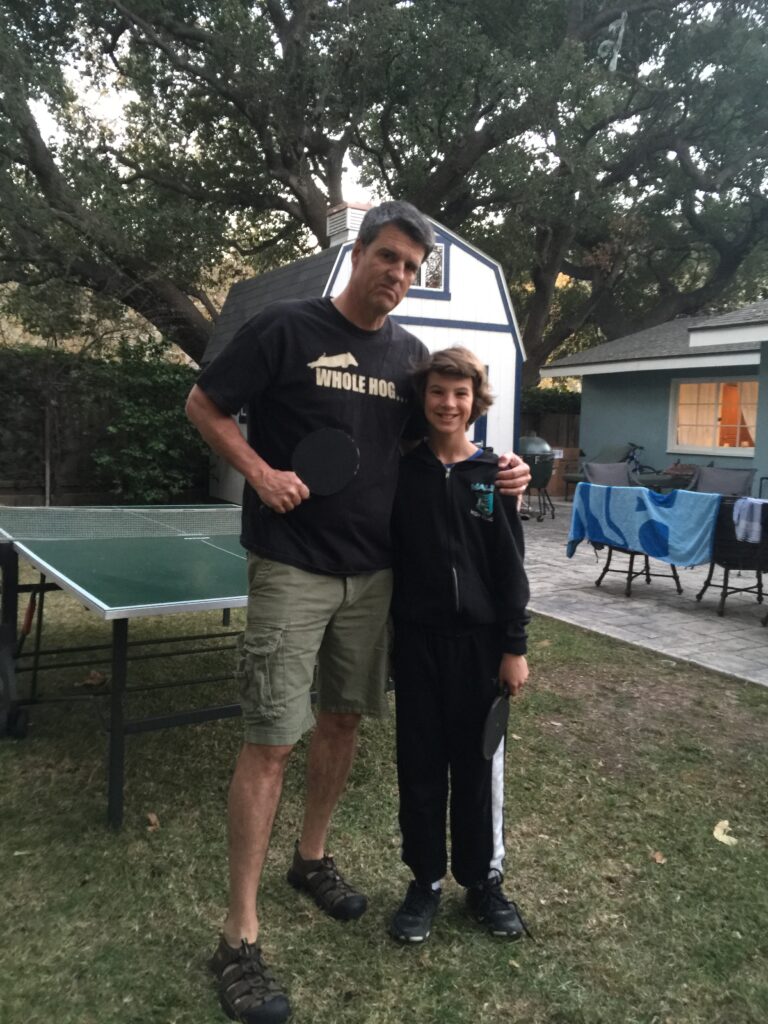
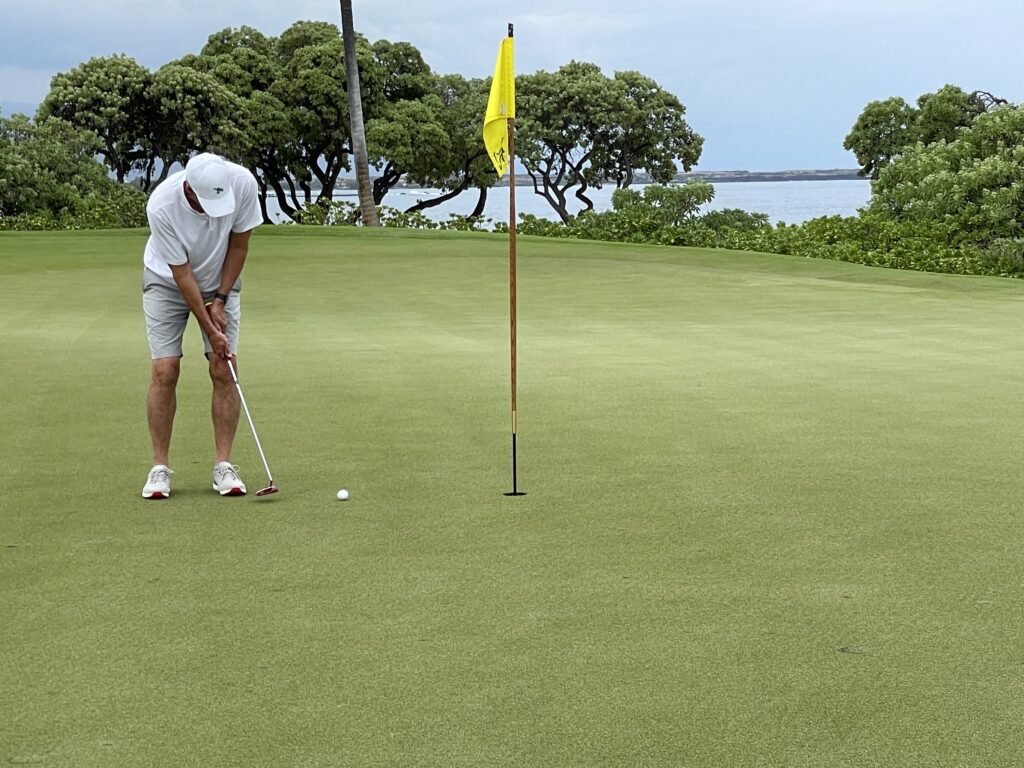
We watched the Oscars on Sunday night. With my newfound time, I actually had the opportunity to watch most of the nominated movies this year. I loved CODA, and I was pleasantly surprised to see it win. Don’t Look Up was one of the funniest movies I’ve seen in a while, but I thought that it was too political, even for the Oscars. Belfast was beautiful and was the type of movie I thought the Oscar people would love. And Summer of Soul was one of the best films I’ve seen in a long time. Thanks to my friend Bill for recommending it to me – as he said, it’s a movie that fills up your heart. And in the interest of staying positive, I will just say that there were many things to celebrate in this year’s Oscars show.
Back to the movies. When I was little, my parents brought me to the movies several times a year. We all still laugh about scenes with Inspector Clouseau (“Does your dog bite?”), anything from Mel Brooks (“What in the wide, wide world of sports is going on here?”), and so many others. It has been an important part of parenting for me too. Watching movies with my sons was always a highlight. There’s not much better than laughing together, and I love that my children had heroes we could root for. It’s still a huge part of their lives, and I know that will continue as long as they live.
I think you can tell a lot about a person from the movies they love. There are several films that I watch over and over again. I can’t even count how many times I have seen each of the movies listed below – probably between 10 and 40 times. They are old friends. If I just watch any of them for even 20 minutes, that’s OK. I know I’ll see them again, so it’s easy to walk away.
You might see my list and think that there’s not much to me. An old friend who knows me very well used to joke (kind of) that I was “a mile wide and an inch deep.” Maybe my friend is right, but these movies are special, and I embrace whatever they say about me.
I love stories. In most cases, when times are tough, or when things don’t go the way they are supposed to, there’s always the silver lining that it will create a great story. One of my favorite things about Abraham Lincoln is that he used stories to make a point or just to lighten a tense situation. It was charming and made him a great campaigner. For those closest to him, Abe’s stories annoyed the hell out of them. I have read that there was no small amount of eye-rolling when he would say, “That reminds of the man who . . .”. As we say in my family, keep on telling a story or making a joke until everyone is tired of it, then really start to hammer it home. If it’s good enough for Abe, it’s good enough for me.
Here are four movies that tell stories that speak to me so well that I watch them again and again and again:
- Princess Bride: I love everything about this movie. From Peter Falk narrating it, to Fred Savage hating it, then liking it, to every single character in it. In our family, we just have to say certain phrases, and we know the thought we are trying to convey. “My name is Inigo Montoya,” “That is the sound of ultimate suffering,” “Booooooo!,” “Have fun storming the castle!” and “Inconceivable!” I could keep on going. It’s a perfect movie that turns storytelling into an art form. And I never tire of it.
- Big Fish: It’s a father-son tale, where the son is pretty much estranged from his father, because of all of the crazy stories that his dad makes up and retells again and again. He longs for a closer relationship with his father, but his father’s incessant stories keep him from doing that. Or do they? I don’t take many quotes from this one, but it’s a storytelling classic about storytelling.
- A Knight’s Tale: Heath Ledger at his best, and how do you not like a movie that includes Chaucer. It’s a quote-fest of a movie about friendship, dreams, and good versus evil. And the mix of contemporary music (Queen, David Bowie) with medieval pageantry makes it nothing short of breathtaking.
- Star Wars IV, V, and VI: Has there ever been a better storytelling movie series? I remember seeing Episode IV: A New Hope in the theater with friends, and when it was over, paraphrasing Vin Scully, we could not believe what we just saw. IV, V, and VI were so good that they make all of the others highly enjoyable. Yoda’s wisdom (“Fear is the path to the dark side. Fear leads to anger. Anger leads to hate. Hate leads to suffering”), Luke’s whining, Obi-Wan’s coolness, Darth Vader’s conflicted evil (“I am your father”), Droids, and Wookies. “Let the Wookie win” is good advice in a number of situations.
Though I love stories well told, comedies are my favorite genre of movie. I believe that each of the films below represent comedic genius. Here are some of my favorites, and yes, I have watched them dozens of times:
- The Jerk: I owned Steve Martin’s comedy album in high school and played it until the grooves wore out. I lived for the Wild and Crazy Guys appearing on SNL on Saturday nights. Like Navin R. Johnson, I took a picture of my name the first time it appeared in a phone book, and I said, “Good things are going to start happening to me now.” I actually could have expanded this to any movie featuring Steve Martin, but I’ll stick to my rules.
- Office Space: Damn, this movie is funny. It’s so dry, but it’s perfect. How many situations was I in as a teacher or principal when I had to do a stupid “TPS Report.” And I knew as a superintendent, I wasn’t happy when I created that requirement for others. Beating the daylights out of a glitchy office machine is something so many of us dreamed of. Bad bosses, heartless consultants, and outstanding slogans like, “Ask yourself, is it good for the company?” I love it all.
- Wayne’s World: Another quote fest. I even have Tia Carrere’s “Why you want to break my heart” song on some of my playlists. Rob Lowe almost steals the movie, and Wayne and Garth are suburban heroes. I’ll party on with those guys many more times in my life.
- Zoolander: Ben Stiller and Owen Wilson, with a cameo from David Bowie, are perfect. The gasoline fight with Wham’s “Wake Me Up Before You Go-Go” playing in the background is about as good as it gets. I’ll admit that I’m not really, really, really, ridiculously good looking, but I can live vicariously through this movie.
- This is Spinal Tap: My friend Carolyn sent me a text about the greatness of Spinal Tap, and my first thought was to make this whole blog post about life lessons to be learned from Spinal Tap. I still might do that in the future, but for now, the movie that invented the Mockumentary genre is my favorite movie of all time. Some call it the greatest comedy of all time. And this movie does indeed go to eleven. I think that in my next life, I’ll forsake my college education and meaningful careers, and I’ll be a rock and roller. I don’t need to be famous, but the life is something I believe I would love. This is Spinal Tap did nothing to dissuade that dream.
While comedies are wonderful, I do have one go-to movie that I will watch when I’m down. I don’t get sad very often, but life kicks you in the teeth sometimes, and I am not immune from the pain. For me, one of the best things I can do when I go to this place is to bathe myself in it. I don’t look for movies to cheer me up. On the contrary, I look for a film that reminds us of how crappy life can sometimes be, while showing that there are glimmers of hope that make it worth living:

Tender Mercies: When I want to accept and embrace that sadness and suffering, I watch Tender Mercies. Robert Duvall is my favorite actor of all time, and this is Duvall at his best. He plays a washed-up country western songwriter. If there’s anybody who embraces sadness more than a country western songwriter, I’m sad for them. Yet even with all of the heartbreak, the movie ends with messages of redemption and hope.
So those are my all-time-watched-a-gazillion-times-already-and-I’ll-keep-on-watching favorites. I’d love to hear from you about what movies never get old for you.
Thanks for reading.
To get updates on when my next post comes out, please click here!
Alternate Title: Parents and Tasmanian Devils Can Peacefully Coexist
Our youngest son, Dawson, came home from college this weekend. It’s Spring Break, and he is in town for 10 days. Jill, Duffy and Maggie Mae (our Scottish Terriers), and I are thrilled to have him home. My good friend Chris Erskine wrote about his son, who is the same age as Dawson, coming home from college in his post this week, and he said it perfectly. (Actually, Chris Erskine is not my good friend, but he is a true writer, and his writing makes me feel like we are friends. He shares enough about the good, bad, joyous, and painful elements of his life to let me in, like a good friend would. Have I ever met him? Well, no. Not yet.) But anyway, my good friend Chris wrote about his son this week, “Yeah, three months since he’s been home. Too long. Forever. For 18 years, I saw him every morning, every night. The house wasn’t a home without him. He took his first steps in this place, said his first words, spilled his first juice box all over my shirt.” Exactly.
That pretty much describes Dawson, except he took his first steps during a faculty meeting at Malibu High School. (Please don’t tell his mom. She thinks she was there for his first steps!) He lived in our house – the same house – for his entire life, until this fall. I still can’t get over the one-house-for-18-years thing. Unlike Dawson, I lived in at least six different houses in five different cities before I left for college. None of that moving actually mattered in my very happy childhood, but it must be interesting to live in just one house and have just one bedroom for the first 18 years of your life. And even though empty nesting is going well, our house is more of a home when he’s here.
Our older son, Ryan, is 31. He’s been out of the house for 13 years, and even though I talk to him several times each and every week, I still miss his presence in our home and look forward to the next time I see him.
That being said, after a week of having one of them home again, I do have to admit that their return, and the quick transformation of the bedroom from a neat, pristine guest bedroom into, well, not that, and finding dirty glasses, dirty plates, and leftover food in unexpected places, is a reminder of what it was like to have a Tasmanian Devil (or two) in the house, and it won’t be totally awful to have the house back to ourselves again. I look back at this paragraph and I don’t like at all that I sound like my Dad talking about me when I was their age.
I know my parents felt the same way when we were kids. Tuesday’s Wordle answer, “SLOSH,” reminded me of a Tasmanian Devil moment when the four of us kids, probably aged 4, 6, 7, and 8 were upstairs taking baths, “safely” out of the way while my parents were hosting a lovely dinner party. Compared to the four of us, Ryan and Dawson are very tame Tasmanian Devils. I’m not sure how it all got started, but we ended up having an epic water fight in the upstairs bathroom, featuring a lot of splashing and water sloshing over the edges of the bath. We would have gotten away with it, too, except for the fact that said sloshed water magically made its way through the floor down to an opening in the ceiling holding the beautiful crystal chandelier suspended above the dining room table. It started as a drip, drip, drip that raised diners’ eyebrows and soon turned into a steady stream of water pouring down onto the dinner table, prompting the guests to run for safety, and my mom to frantically scramble to save the food. My dad did not help with the food saving, as he was too busy running up the stairs to address the problem directly. And boy was he mad. He stopped us mid-slosh, making sure that we all knew how angry he was. If one’s vocal volume was the main factor for a parent of the year award, my dad would have won in a landslide in that moment!
So the Tasmanian Devil thing is something my kids come by honestly.
One of my theories about parenting is that with each child, parents have somewhere between 14 and 16 years to impart lessons in their parental role. That happens by setting and enforcing the rules, developing good habits, exploring children’s interests and passions, instilling a code of morality, building self-esteem and self-discipline (those two can be at odds with each other), and doing all of the things that make parenting unbelievably difficult, yet incredibly meaningful. But somewhere in that 14 to 16 age range, these young adults reach a point where the natural consequences of their mistakes or bad decisions are far more impactful than any consequences a parent can impose. For me, that has not meant that my parental role is over, but it has meant a shift. It has moved me into a mentor/friend role, and optimally I will stay there for the rest of my life.
Somewhere in that 14 to 16 age range, these young adults reach a point where the natural consequences of their mistakes or bad decisions are far more impactful than any consequences a parent can impose. For me, that has not meant that my parental role is over, but it has meant a shift. It has moved me into a mentor/friend role, and optimally I will stay there for the rest of my life.
Mark Twain wrote, “When I was a boy of 14, my father was so ignorant I could hardly stand to have the old man around. But when I got to be 21, I was astonished at how much the old man had learned in seven years. There should be a get-even quote for parents that goes something like, “When my child child was 14, their incompetence as a human being made me think I was a complete failure as a parent. But by the time they were 21, I was amazed at how much my parenting lessons had sunk in over the last seven years.”
To me, those seven years are a huge transition time. They are challenging years because each child and parent is figuring out how to navigate to this new role in the relationship. The transition time from parent to mentor/friend can be painful, but having experienced it, I know there’s nothing better. I do miss the 18 years where we lived together 24-7. At the same time, empty nesting is not bad at all. Pretty darn good, actually. And during times like this week, when one of my boys is back in the house like old times, I’ll drink it all in, accept the anthill of bad with the mountain of good, and remind myself how truly fortunate I am, and how much I have to look forward to.
To get updates on when my next post comes out, please click here!
March 15 is the Ides of March. The phrase ‘Beware the Ides of March’ is yet another Shakespeare quote still in our lives, made famous as a fortune teller’s warning to Julius Caesar about his impending death. I’ve been in a hilarious email exchange this week with about 20 high school classmates, reminiscing about our days in Latin class. Our teacher was a larger-than-life man who had very strict rules for all assigned work, a low tolerance for annoying noises mysteriously coming from the class, a strong slap to the face (or the occasional double-whammy if it was deserved) for those of us who made his life difficult, and, especially for a Catholic priest, an odd fascination with Julius Caesar. He even made us bow our heads for a moment of silence on the Ides of March, the day of Caesar’s death. I was not the best-behaved student in that class (I may or may not have been slapped a few times), but I emerged with stories that still matter. Over forty years later, my friends and I still share stories of antics from that class and how we all bonded from the experience.
But lately, the Ides of March has been nothing compared to March 13 (the Ides Minus Two), which happens to be my birthday. Let’s review my last three birthdays, shall we? At least Caesar was warned something bad was coming.
March 13, 2020. As the clock struck midnight and I turned 58 years old, my leadership team and I were meeting in my office. COVID was all everyone was talking about, there was news of cases in our community, and fear was high among our parents and employees. I am a big fan of keeping schools open, and the state was making it clear that our district would lose money if we decided to close, but there was just too much unknown. Around 1 AM, we decided to close the schools and move to remote learning. When I met with the management team later that morning, they asked me how long I thought we would be closed. Being the great future teller that I am, I boldly predicted two weeks. They still laugh at me for that one, and for every other prediction they asked me to make. They should have stopped asking me, but they took great pleasure in watching me try yet again. My birthday that year was a tough day that required tough decisions, and like all decisions I made over the next 15 months, I pleased some people with it.
March 13, 2021. My team and I were trying to work miracles in order to safely get our students back to in-person school. By this time, we had already brought back our most impacted students with disabilities, high school athletics (just training, not practicing), elementary school students, and middle school students in grade 6. But we still had to figure out how to safely move students from class to class in grades 7-12 while abiding by all health department rules. It seemed like the health department had completely forgotten how high schools work. I’m pretty sure they all went to high school, but we were constantly saying to DPH, “People! That is not how high schools work!” We were working beyond our physical (and emotional) limits, and we just kept going. I withstood the slings and arrows from those who “knew” we were moving too slow or too fast, and I was bolstered by all of the people who took the time to say thank you. Never underestimate the power of gratitude in how it energizes those who need it. Those were days when almost every minute at home was spent on email or the phone, and there was simply no time to celebrate a birthday. I look back and I am so proud of what our team accomplished, but as far as birthdays go, well, I was proud of what all of us in the district accomplished.
This will irk some people, but here’s a pet peeve. If your birthday falls on a work day, GO TO WORK! You went to school when you were a kid on your birthday. Go to work as an adult. Sorry. Where was I?
March 13, 2022. A warning I should have considered was that Daylight Savings Time started on my birthday this year. I love Daylight Savings Time, and I really don’t mind losing an hour, as it turns me from a ridiculously early riser to just an early riser. But most reasonable people loathe losing that hour. They get angry and cranky about it. And this year, because it was on my birthday, it was therefore my fault. You’re welcome, people. Back to my birthday. Finally, this was the year to celebrate. I was turning 60, and as you know, I’m not working! This was the year when I got the birthday I deserved.
We had invited a few people from the neighborhood invited to join us for a back yard bbq, where I planned to cook way more food than the attendees could possibly eat in three dinners. It was fun planning it, but then, the Ides Minus Two struck. As the week leading up to my birthday started, Jill and I learned that we had both been exposed to COVID by a friend who is highly responsible but who still tested positive. What the hell? COVID is practically gone! The rules are minimal, and I still abide by all of them. I have always abided by the rules (well, not in Latin class), and I still was living my life according to DPH guidelines, but NOW, when no one has it, I might get it? So we followed the rules and quarantined. Admittedly, in spite of Jill’s best efforts, I did so with a bit of an attitude. At first, we had no symptoms, then both Jill and I started a slight fever and a sore throat. The next day, we both tested positive and it was game-on from there. We both had extremely sore throats that made it difficult to sleep. My symptoms went away after a few days, while Jill’s got considerably worse before they finally went away.

This was the first sickness I had experienced in over four years. I keep track of my colds/flus in Evernote. I used to keep track of Jill’s too. I thought I was being very helpful when I would say, “You know, this is your third cold this year. Maybe you should work on some healthier habits.” Surprisingly, she did not think it was as helpful, and in an effort to keep our marriage happy and healthy, I have stopped the public service announcements I was giving her. But I still keep track, and it has been over four years for me!
Suffice it to say, the BBQ has been postponed indefinitely. The highlights of my birthday were phone calls with friends and family (my brother Bill said, “From a little baby turkey to an old crusty gobbler, you have been a great big brother!” Sweet, right?), Facebook good wishes (my first time for that – it’s quite nice!), some outstanding email messages, and my neighborhood friends walking up the street and safely singing happy birthday from the middle of the street. At first it felt like they were singing, “Happy F’ing Birthday to You.” Then, I gave myself a well-deserved mental slap (a lesson learned from my Latin days), and truly appreciated it. It was a wonderful neighborhood moment, and I was grateful, but I still would rather have been with them in the back yard, eating food, playing backyard games, and doing what you should do on birthdays.
I spent time on March 13 doing what I recommended in last week’s blog – writing down what I’m grateful for. It’s a long, long list. Truth be told, I think birthday celebrations are overrated. I feel fortunate to have had the opportunity to solve big problems with bright and caring people over my past few birthdays, and I’ll take the bad with the good. Usually, the bad just turns into yet another life story to share. I think we get in trouble when we think that life owes us anything. Maya Angelou said, “Living well is an art that can be developed: a love of life and ability to take great pleasure from small offerings and assurance that the world owes you nothing, and that every gift is exactly that, a gift.”
But as I said. Beware the Ides of March, minus two.
Mike
To get updates on when my next post comes out, please click here!
I’m a big fan of pursuing happiness. Aristotle even said that doing so was the meaning of life, so I’m in decent company. I know that there are a million ways to define happiness, and that you don’t have to be smiling-laughing-giddy in order to be happy. That’s why many people are moving from the idea of pursuing happiness to the idea of pursuing well-being.
What is mind-boggling to me is that even though most of us reading this live in one of the wealthiest nations the world has ever known, our level of well-being in the United States is not increasing. Depression and other mental health challenges are more prevalent than ever.
I’ve been thinking a lot about this because last week I had the good fortune of being part of a three-hour lecture and Q&A Discussion with Dr. Shashank Joshi, a professor of Psychiatry, Pediatrics, and Education at Stanford. Professor Joshi was a parent at Palo Alto High School when several students died by suicide there. He was very involved with school officials and mental health providers as they worked side by side to address this crisis, in hopes of saving as many young lives as possible. Many districts have followed their lead. Take my friend Ellen for example – when asked why she was a member of her district’s social and emotional wellness committee, she said, “If we can just help to save one life, all of our efforts are worth it.” Ellen is exactly right. Professor Joshi has dedicated much of his professional life to helping students and adults by improving their well-being. But he was devastated by the recent death by suicide of Katie Meyer, a Stanford student who had been an incredibly positive leader on the Stanford campus. There is still a great amount of work to be done.
Depression is a real problem in this country and around the world, and it’s becoming more prevalent.
- 20% of young people suffer clinical depression before adulthood.
- According to a Boston University study, nearly 28% of Americans experienced depression at the beginning of the pandemic, and by late 2021, this figure had increased to nearly 33%.
- Depression rates have been increasing over the last ten years.
So what can we do?
There is a relatively new field of study called positive psychology. It seeks to use research-based techniques to increase personal well-being. A book that Professor Joshi recommended was written by one of the founders of positive psychology, Martin E. P. Seligman, titled Flourish: A Visionary New Understanding of Happiness and Well-Being. I enjoyed reading this his book, though it uses a little more medical terminology than my liberal arts brain can comprehend (I skim through those parts).
Seligman provides techniques that are much more than just good ideas – they are research-based practices that all of us can use to improve our well-being.
- Perform acts of kindness for others.
- Towards the end of the day, set aside ten minutes and write down three things that went well today and why they went well.
- Slow down. (This is a hard one for me). Our society often rewards speed, but mental health is enhanced by going slow, as it allows us to better focus, ignore distractions, plan, and avoid impulsivity.
Want to get motivated? Some of you may know of Questlove, who is one of the founders of The Roots, the band that works with Jimmy Fallon on The Tonight Show. He’s a supremely talented musician and an overall amazing person. Professor Joshi recommended a 10-minute video where Questlove reviews what a typical day for him looks like. While he is incredibly productive, the amount of time he spends pondering, being still, and just thinking is mind-boggling to me. When you add the amount of time he spends on disciplined learning, it’s truly inspirational. And, oh yeah, he does a lot of actual work on top of that. It will make you reconsider how you spend your time. I know it’s doing that for me.
Professor Joshi also shared a study from UC Berkeley, which was conducted as depression rates were rising during the pandemic. This is what the findings suggest that all of us should do every day. For me – this is good healthy living that should extend far beyond the pandemic.
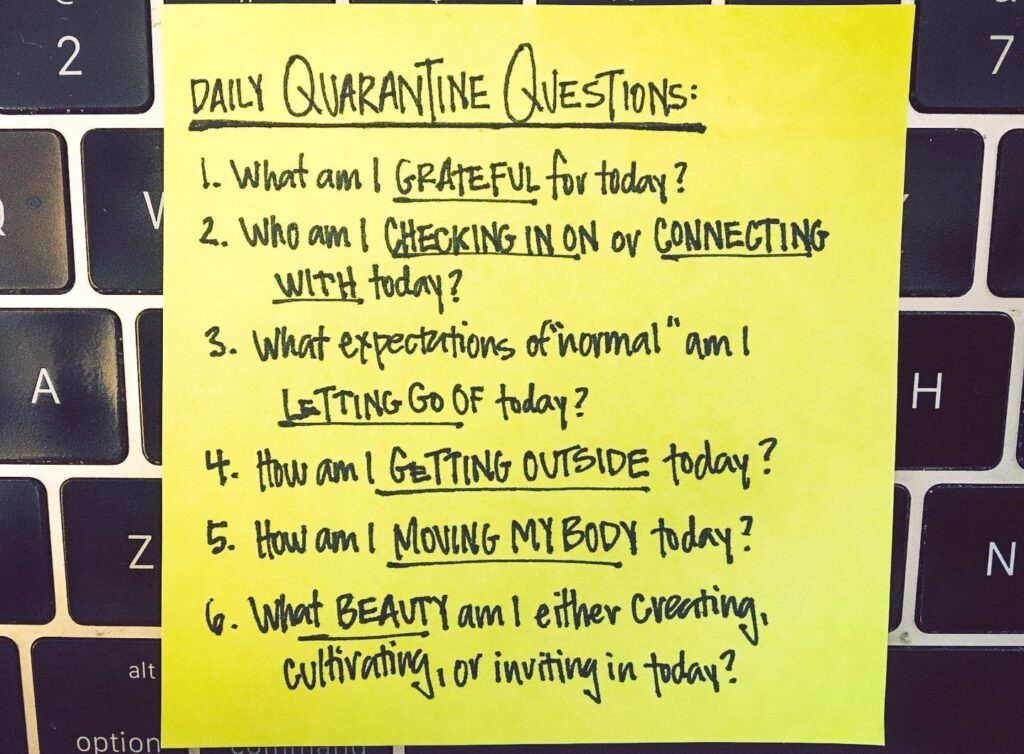
A huge part of Seligman’s book is devoted to changing our schools and the military. He is passionate in his belief that children, as well as soldiers, need to learn how to maintain and improve their own well-being. While schools have been slow to universally adapt these ideas, the military has made a concerted effort to provide this life-improving information to its leaders and soldiers. Seligman details many ways that the military is working to improve soldiers’ lives and to promote post-traumatic growth. He has example after example of ways in which the military is actively seeking to implement his own research and the research of others.
Unfortunately, the level of implementation at the schools has been less successful. This TED Talk by Dr. Nadine Burke Harris should persuade anyone that this is critical work. Dr. Burke Harris is convinced, based on her own research and that of others, that schools can screen students and provide support for students who are most likely to experience mental health issues in the future. By providing that support, schools can improve those students’ chances for healthy living, better academic success, and a more productive life with a greater sense of well-being.
I’m sure that both Seligman and Harris are disappointed with the lack of progress in schools. This is one of the areas where I left my job feeling like I was not as successful in instituting the change that I had once hoped to create. My former district led efforts towards mindfulness as well as overall social and emotional well-being, and we did screen our students to better understand whether that could be contemplating death by suicide. Just like the data mentioned earlier indicates, it was a higher number than you would think. The vast majority of parents were grateful for our alerts to them if there was a concern. In spite of those efforts, I do not believe we achieved anywhere close to a strong level of implementation before I left. I think there are many causes – not enough training, lack of belief by some that it really matters, strong beliefs that academics are the sole purpose of schools, and lately, some opposition by parents to schools making this shift that thwarted our progress. There is much work still to be done.
If you ask almost all parents what they want for their children, they will say that they want them to lead happy and meaningful lives. We as parents need to do our best to lead by example. For me, that means striving to do better for myself and for others, and talking with my children about these efforts. I hope we can get to a day when this type of self-care is also taught in our schools. Let’s ensure that students have a better chance of leaving campus each day with the tools they need to maximize their own well-being. This is relatively new learning for me over the last ten years, and I agree with many military members who have gone through this training: my only regret is that I wish I had learned this earlier. It would have made me a better educator and a better friend.
I hope you find something in all of these resources that pushes you to examine and develop new habits to enhance your own well-being, and to support those we love in that same pursuit.
To get updates on when my next post comes out, please click here!
Photo by Gerd Altmann via Pixabay